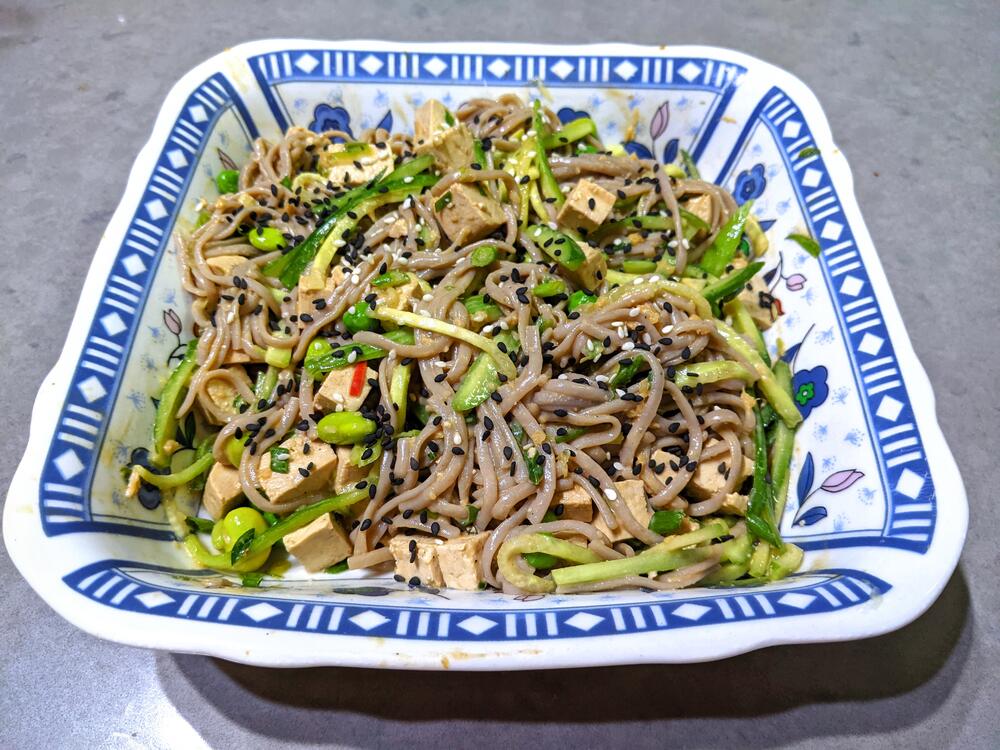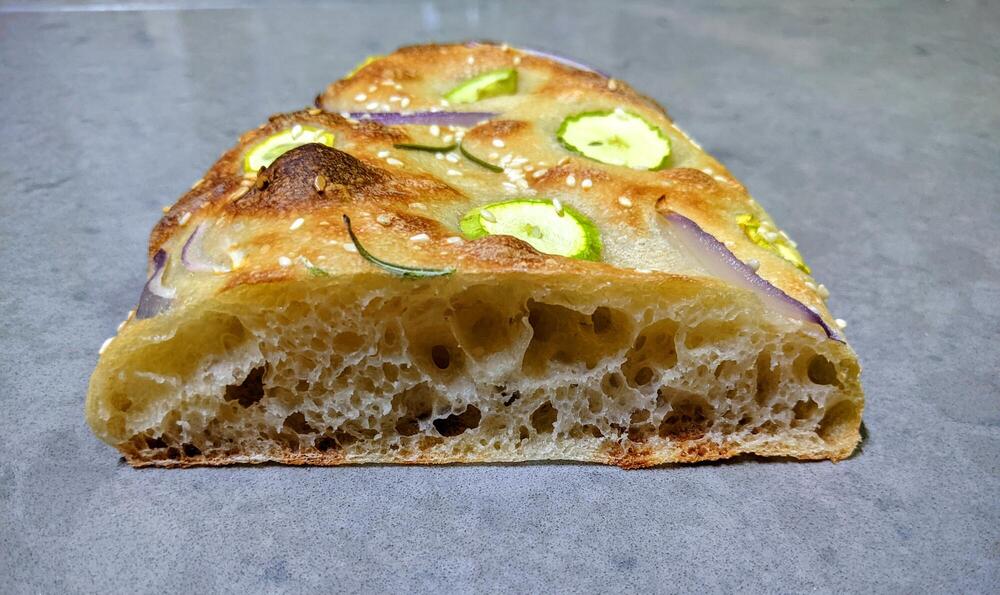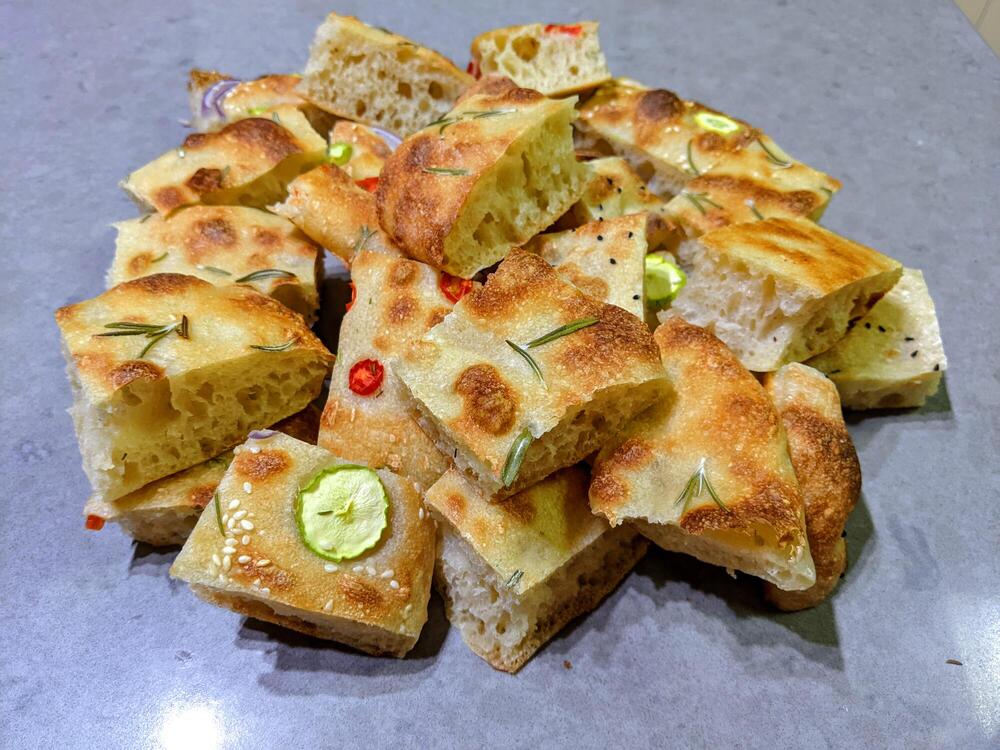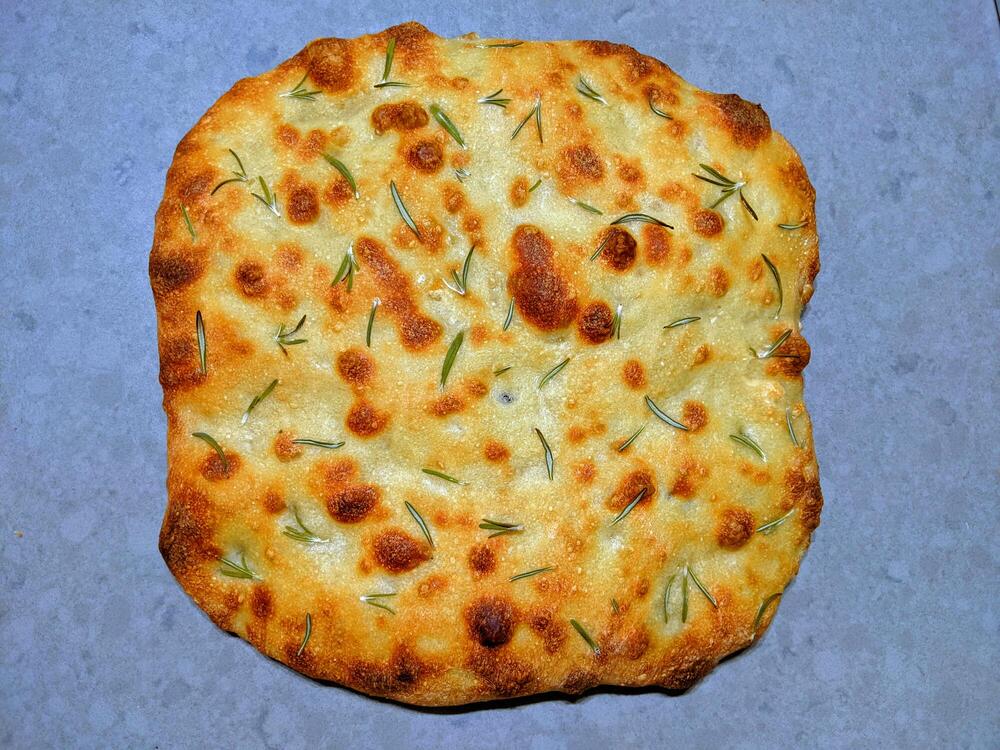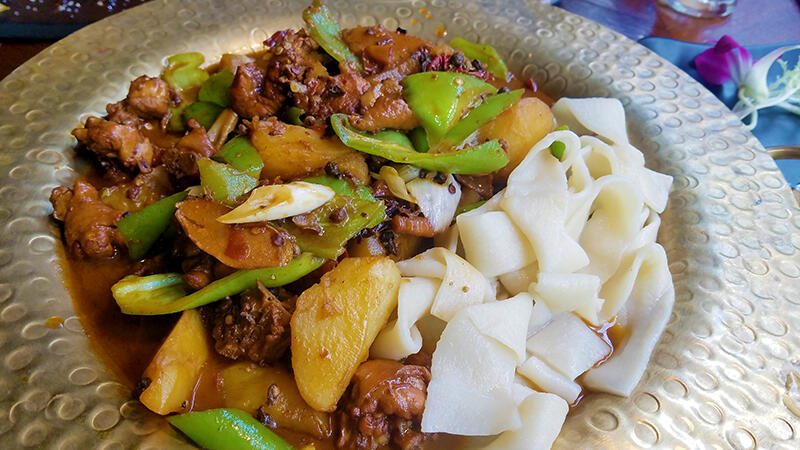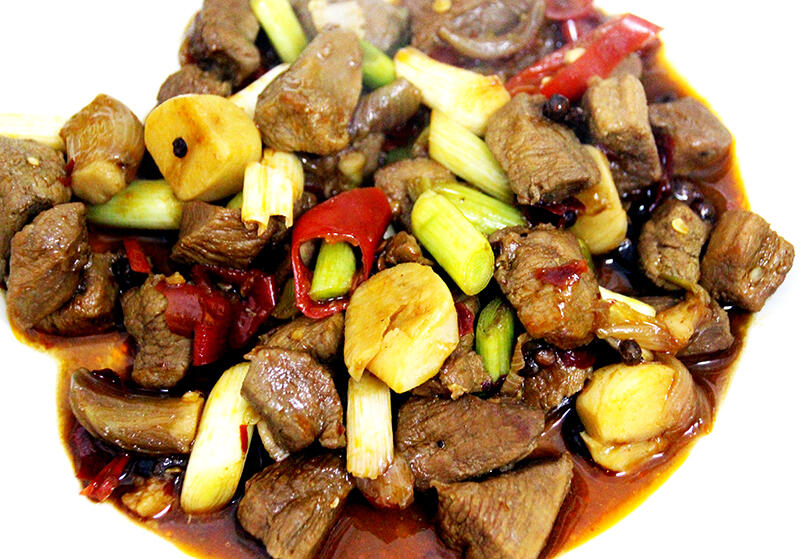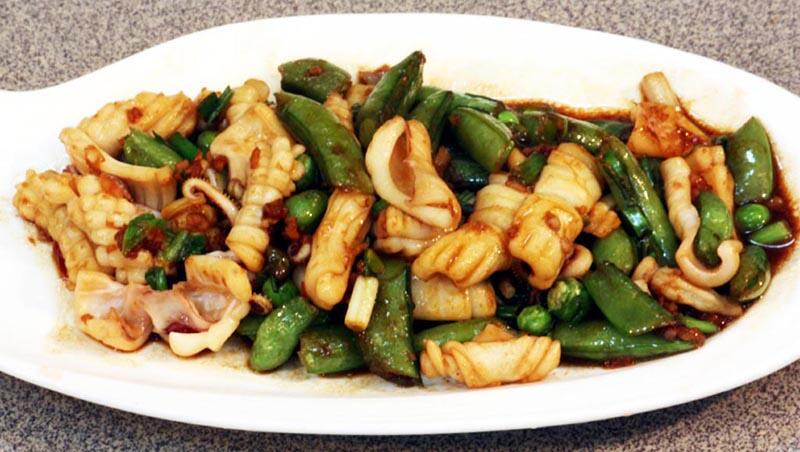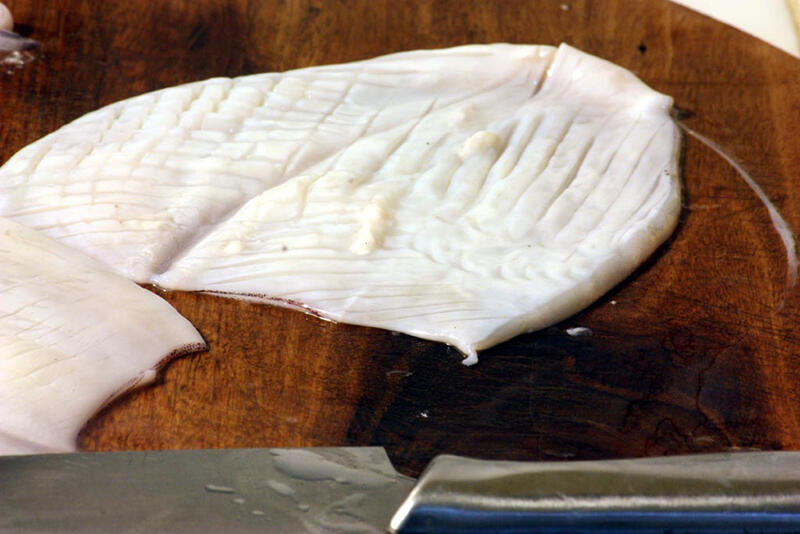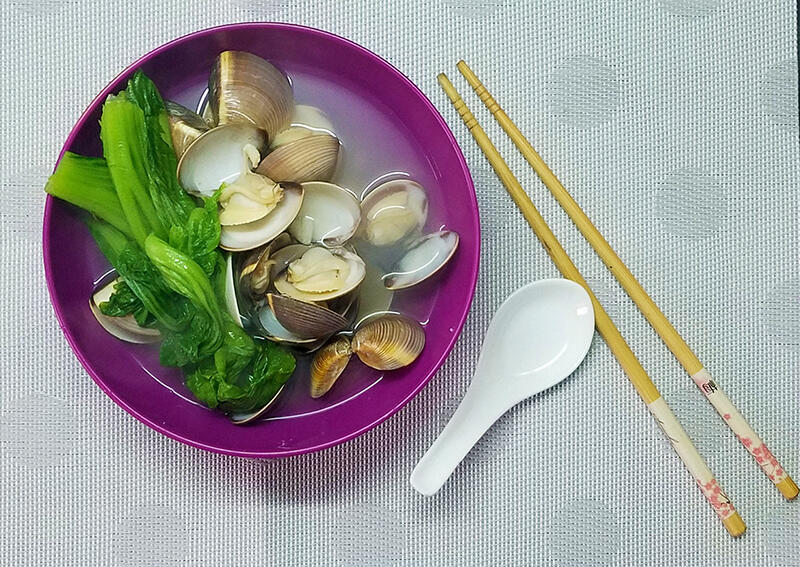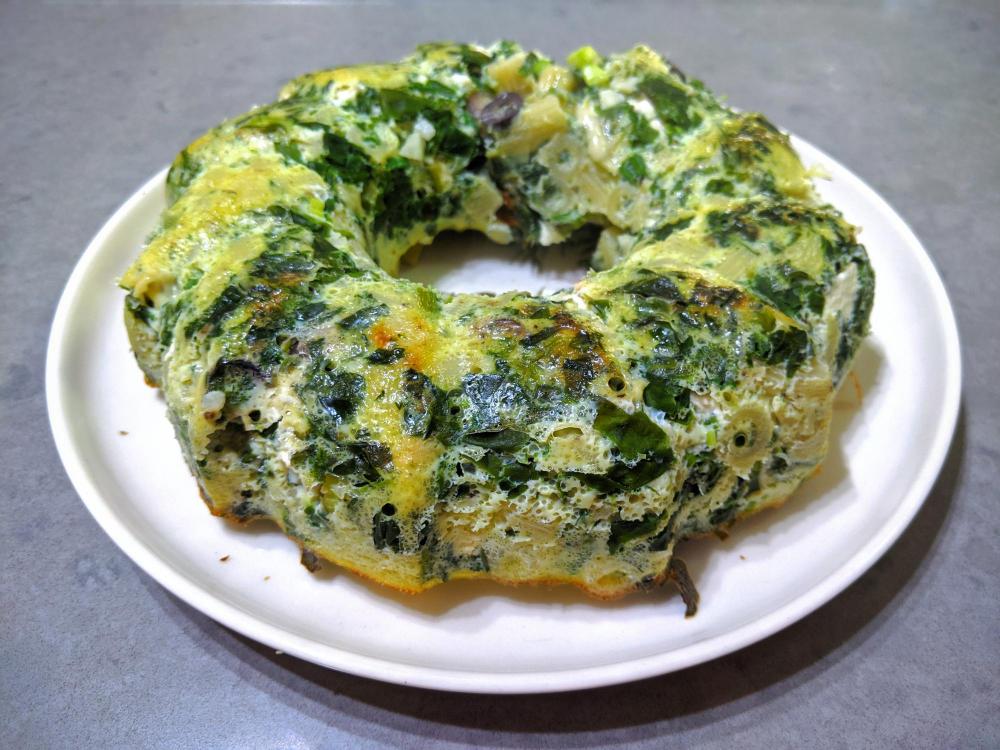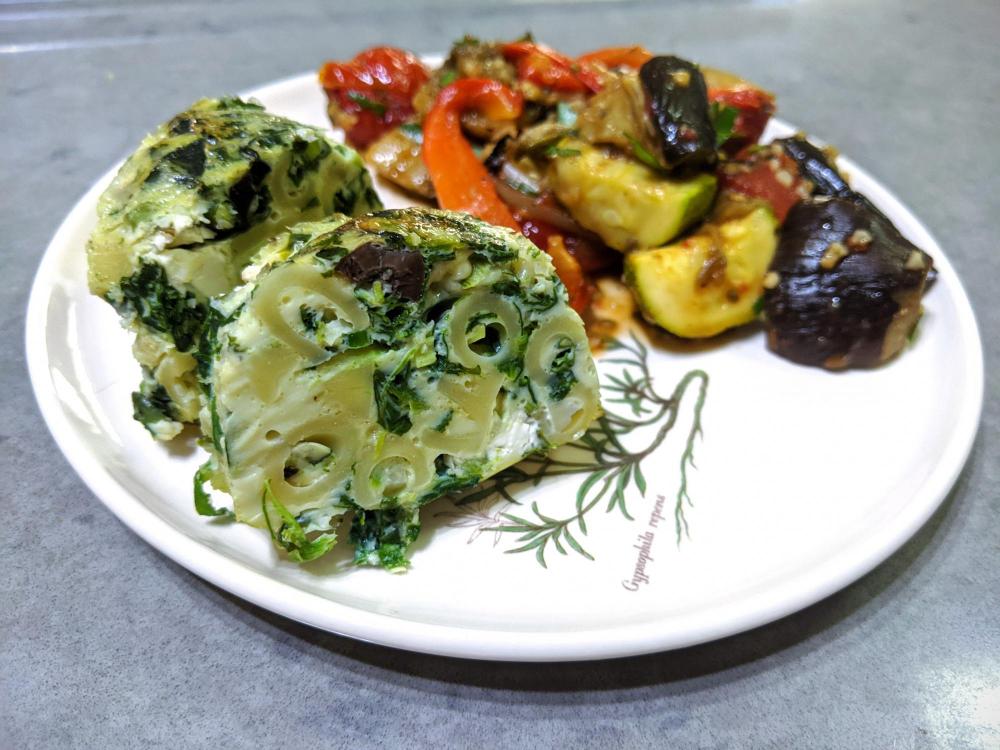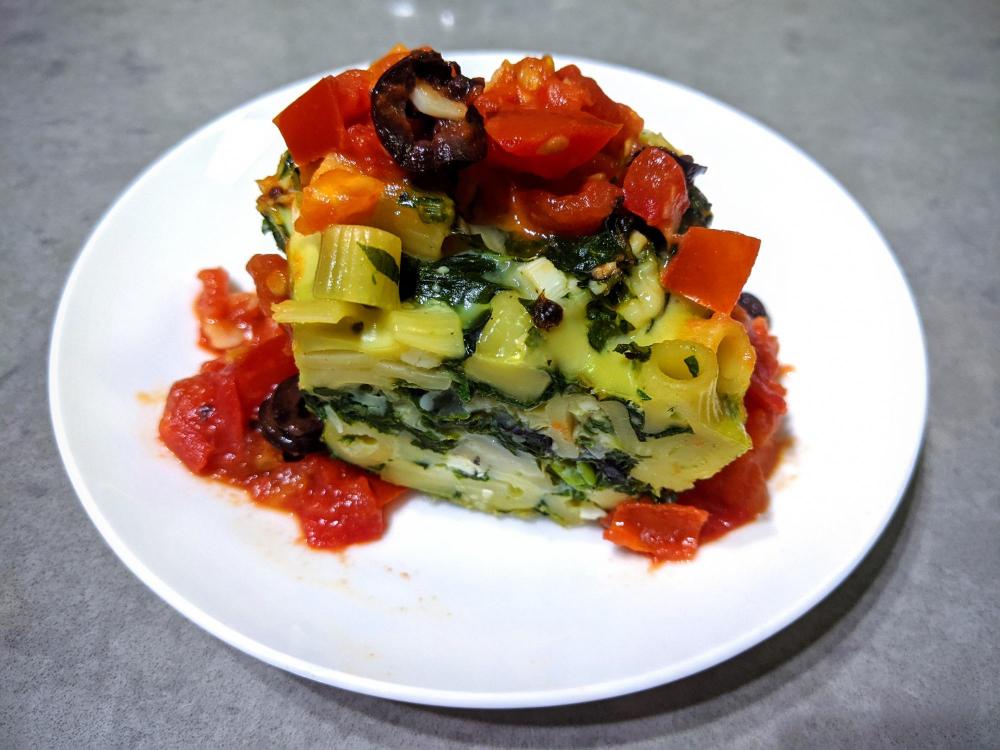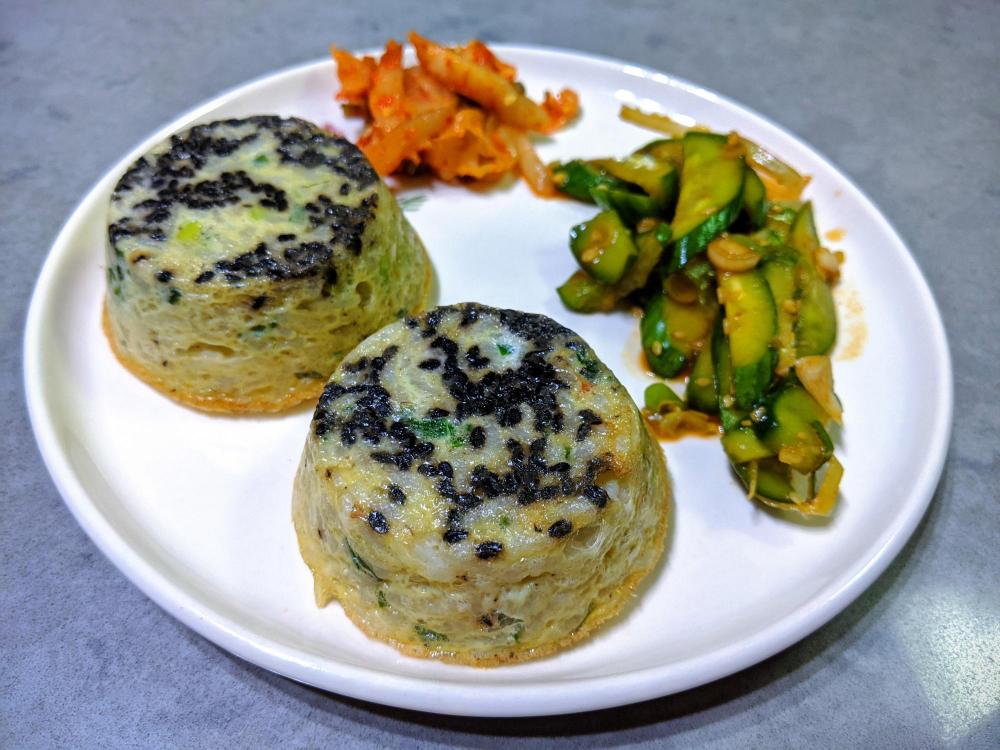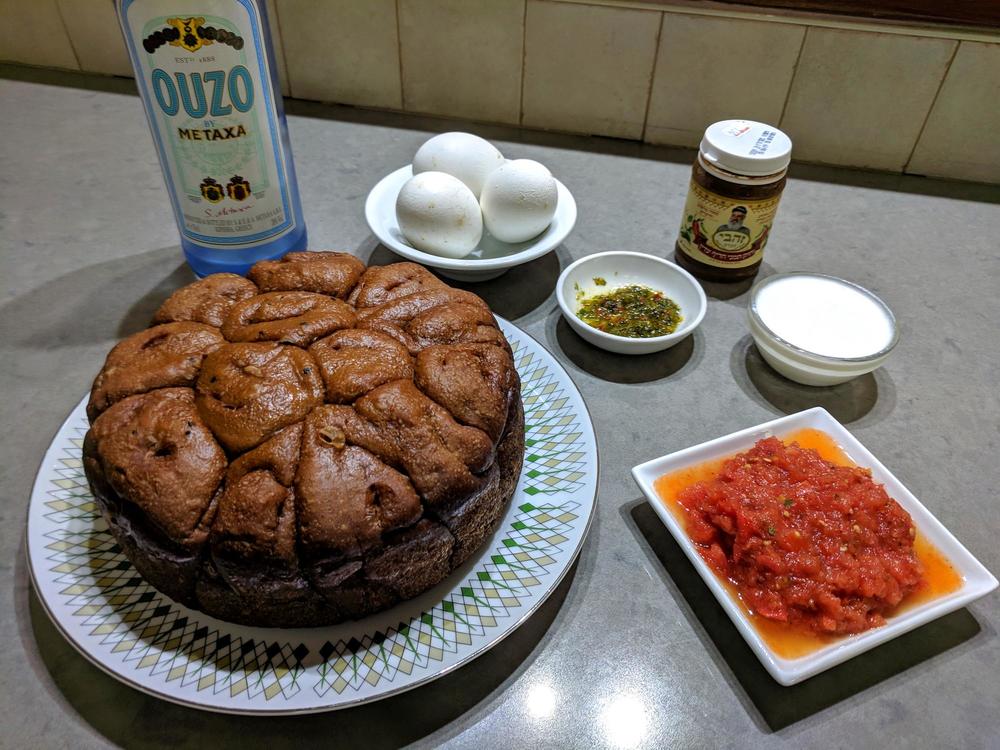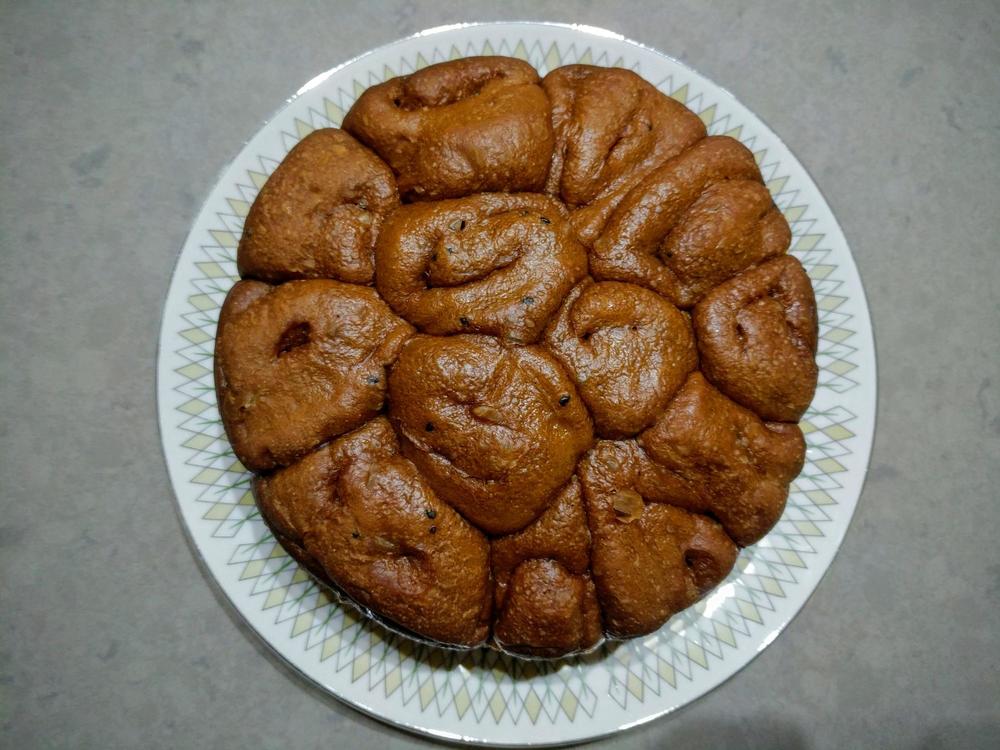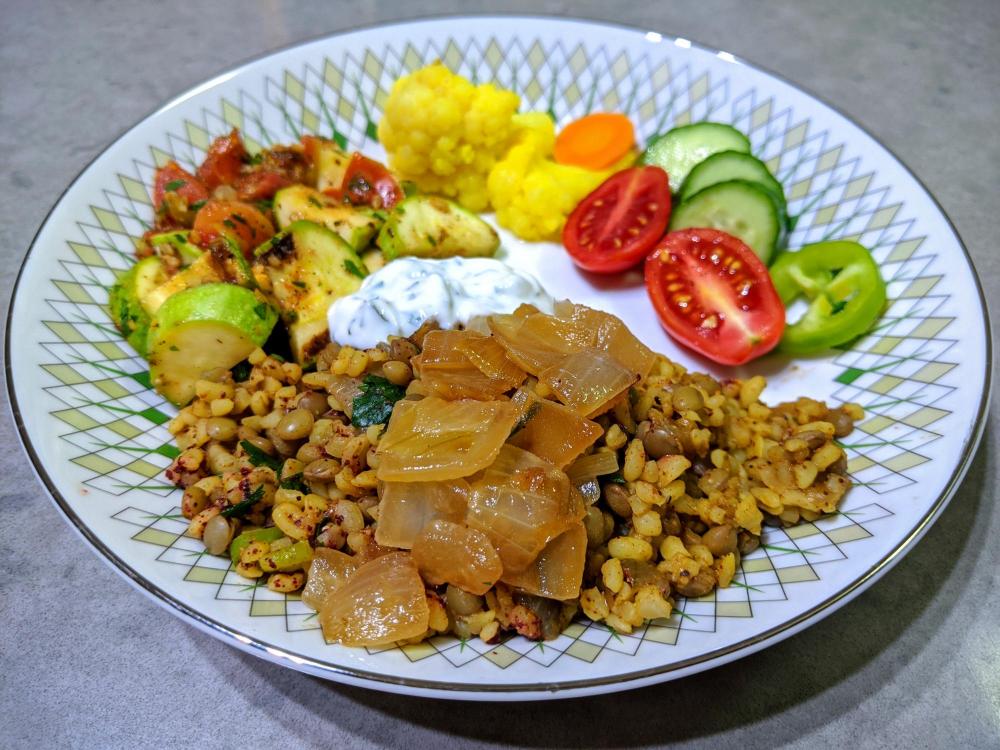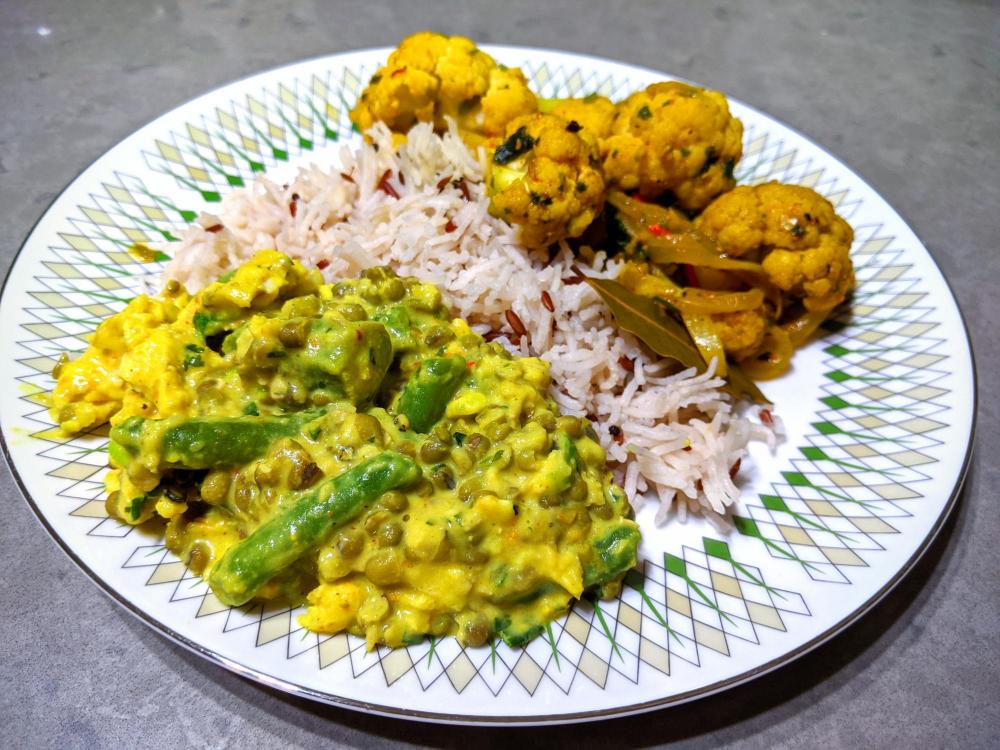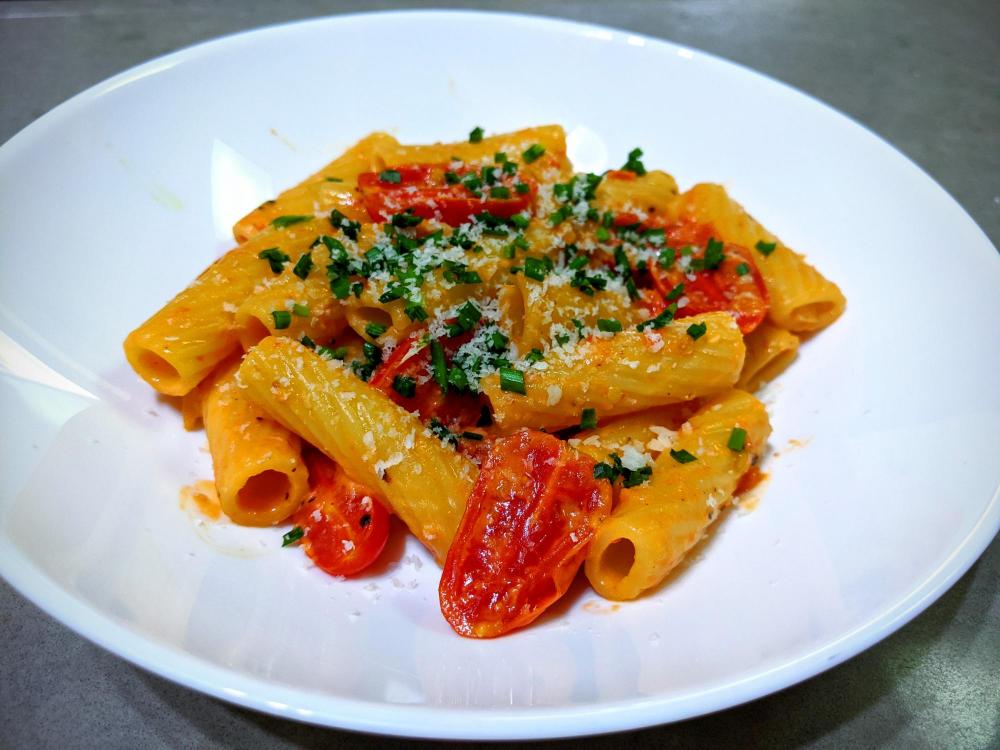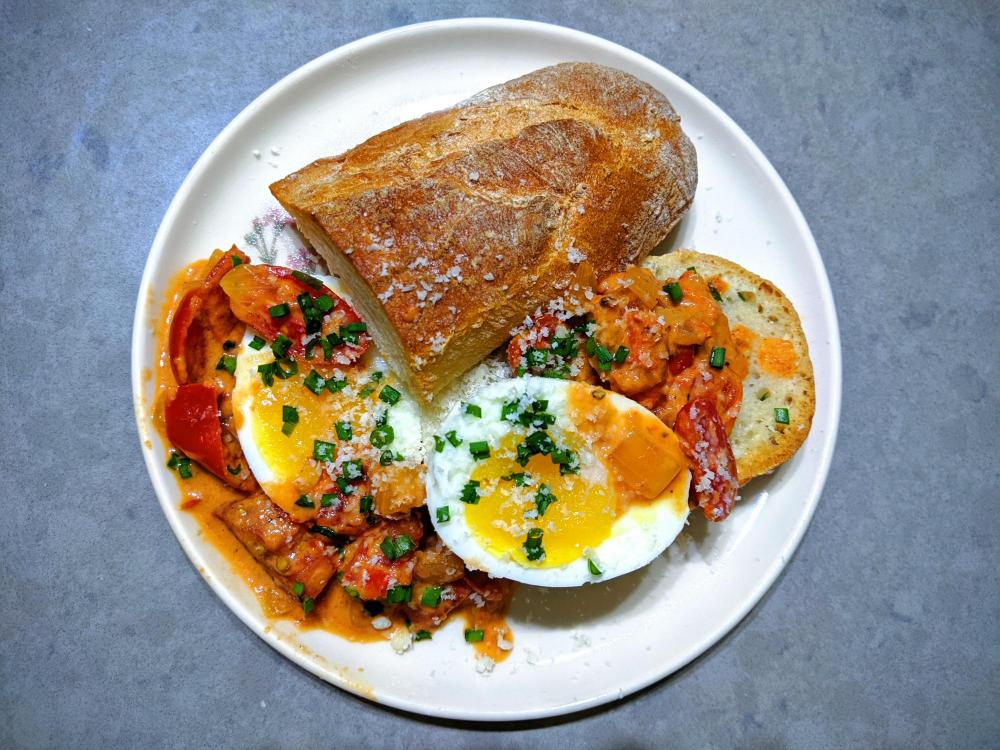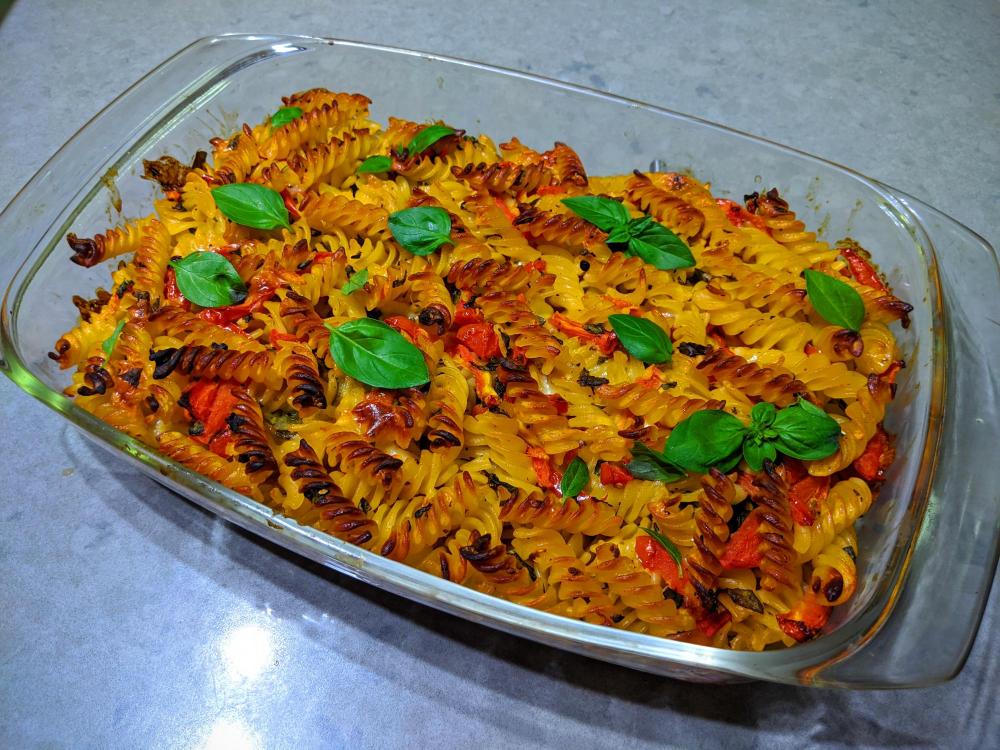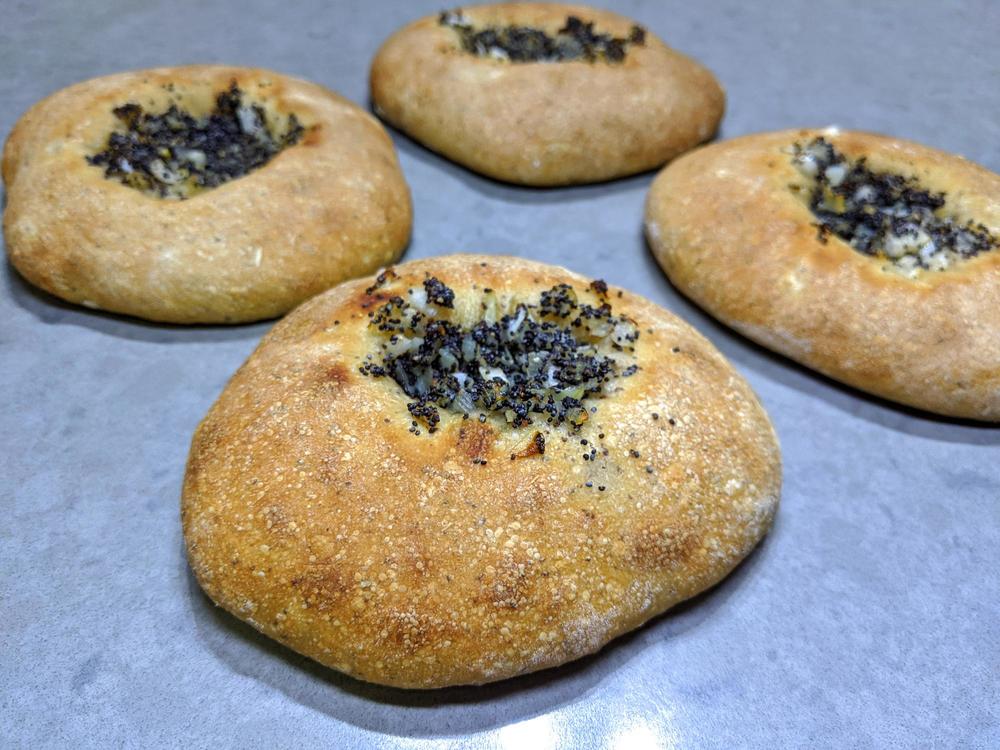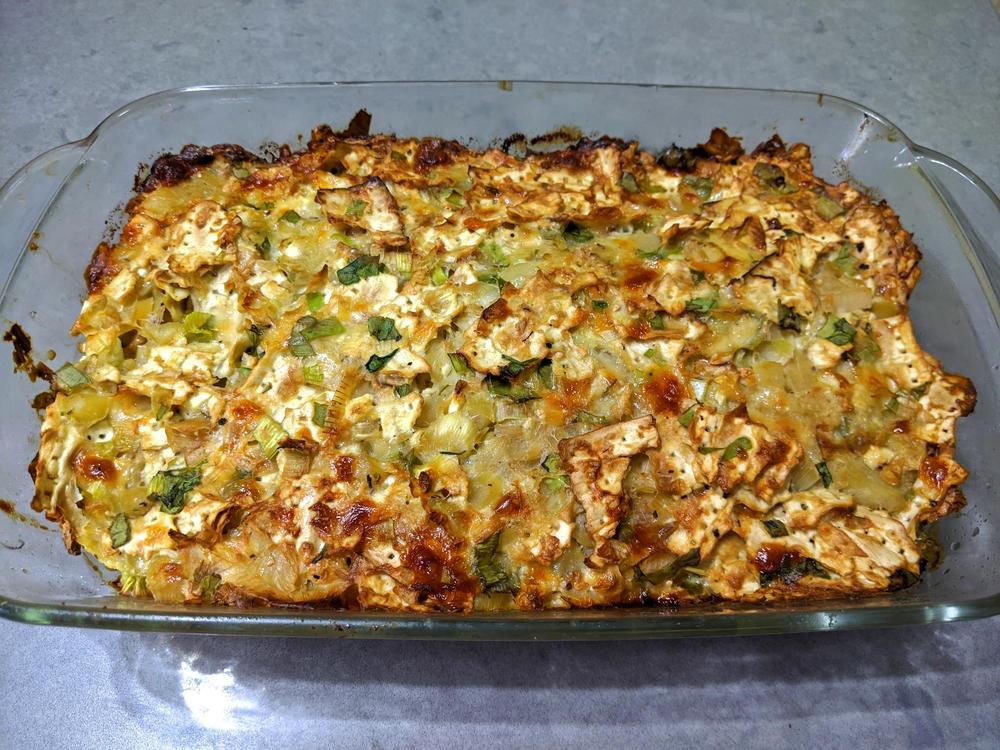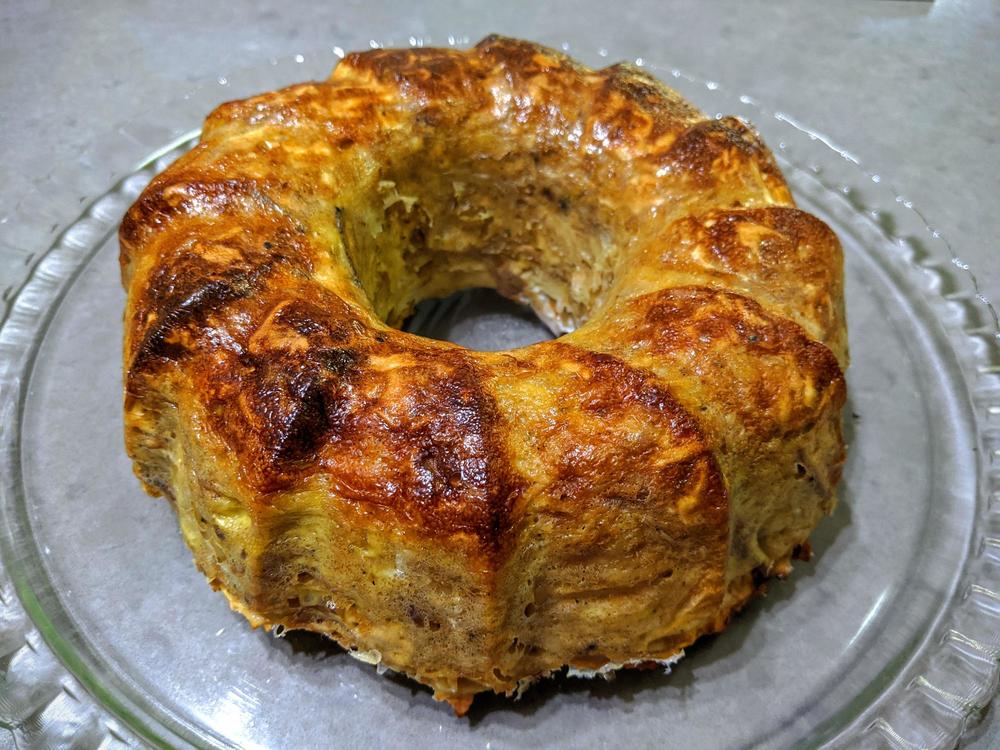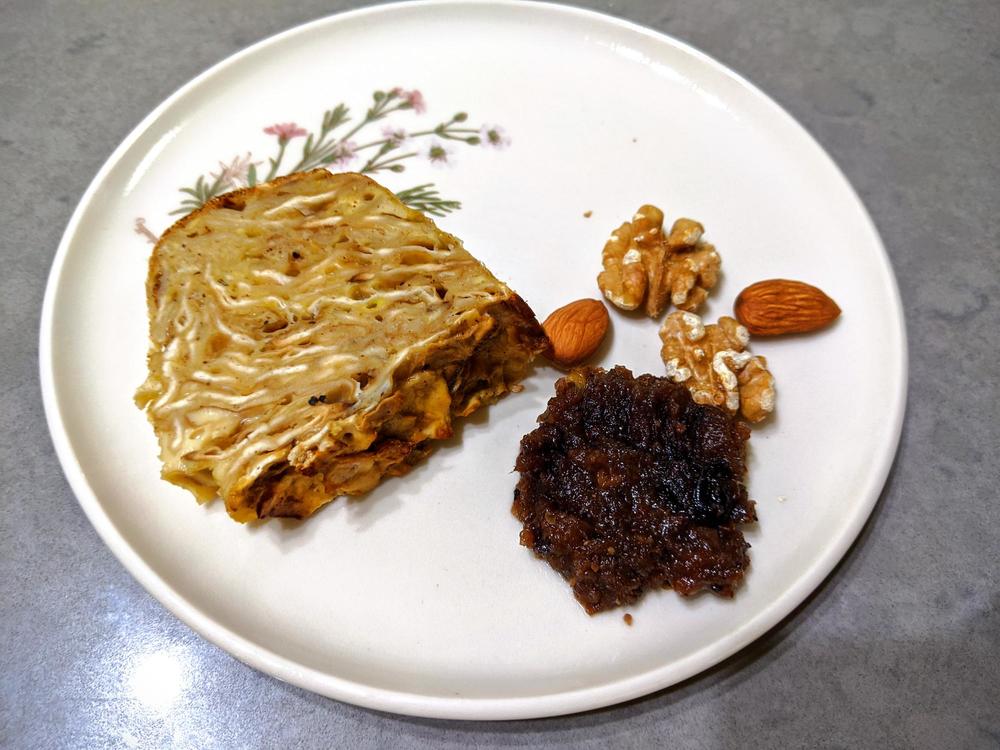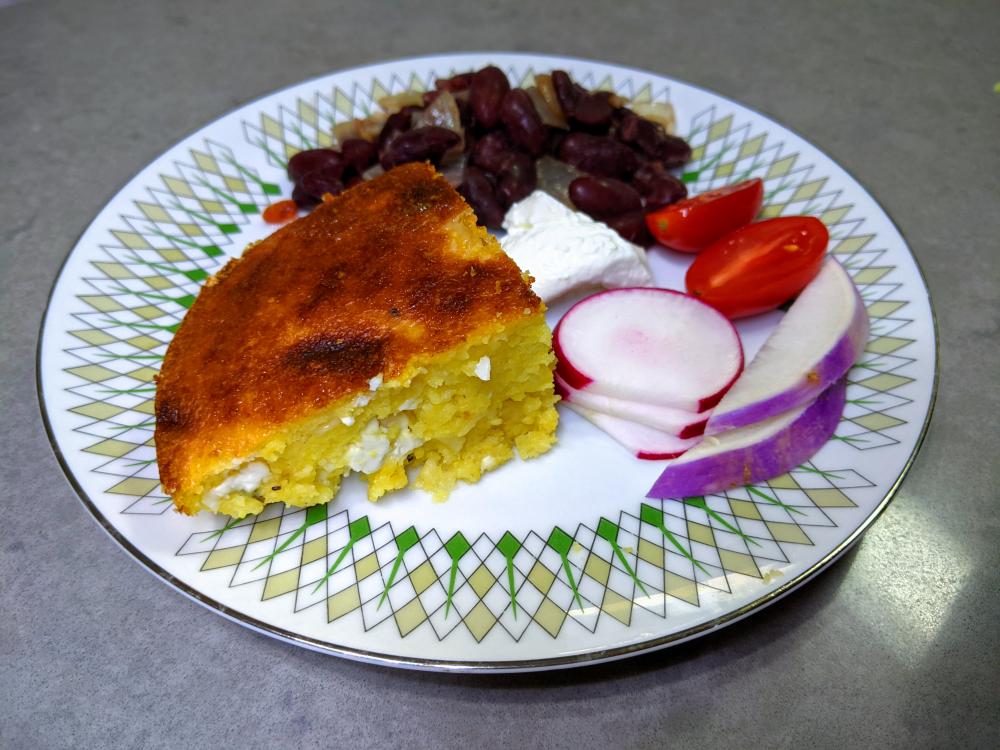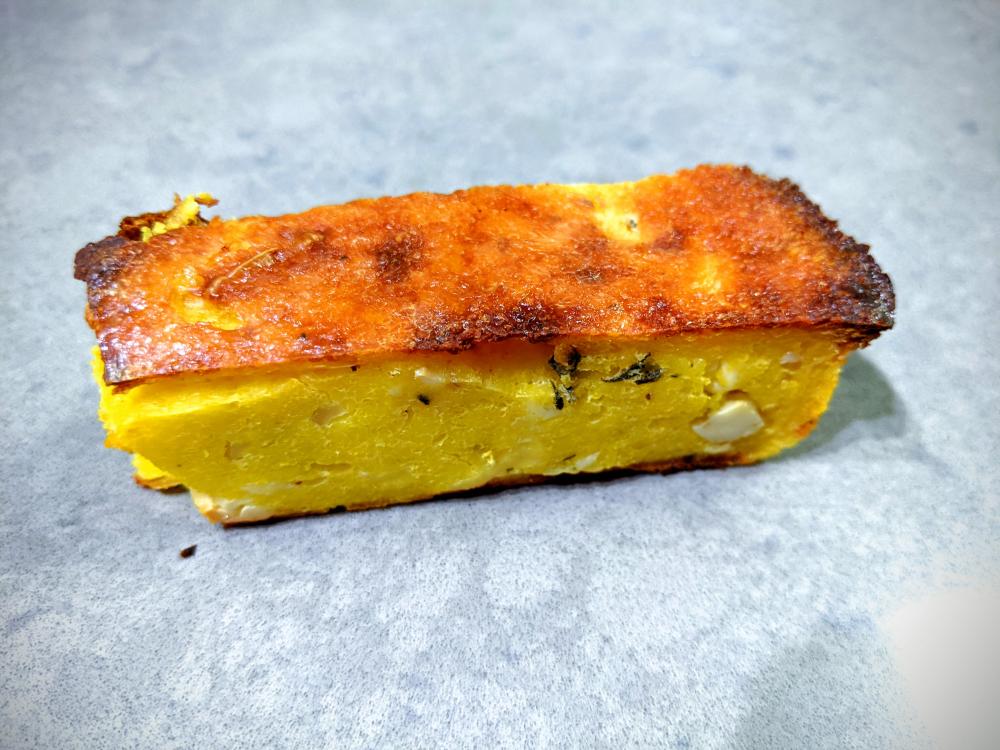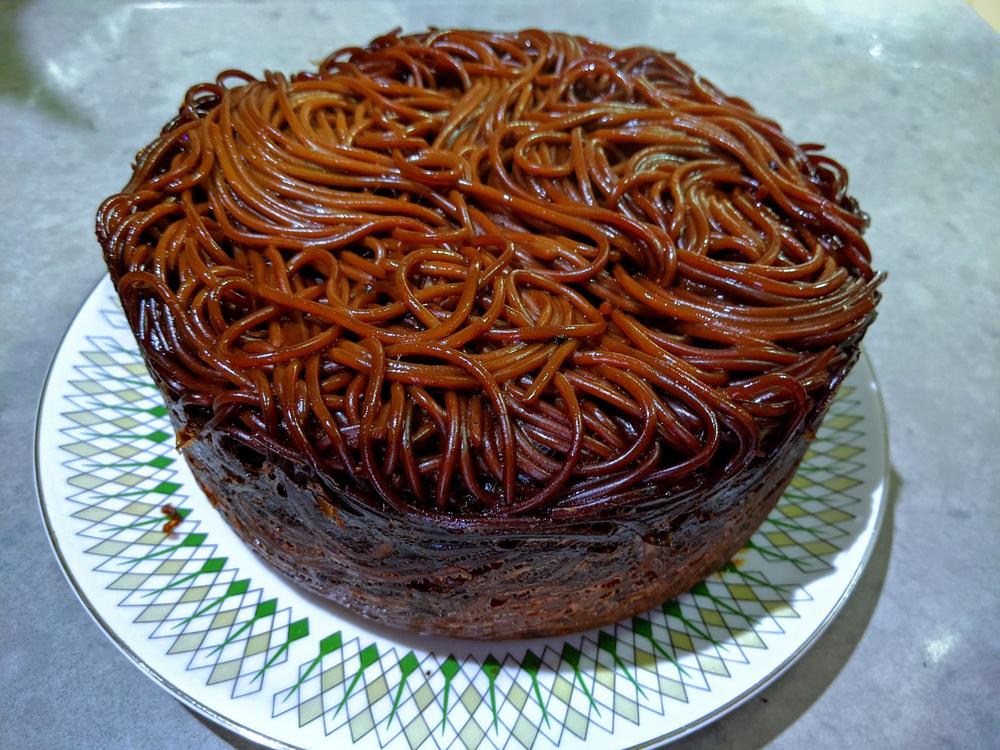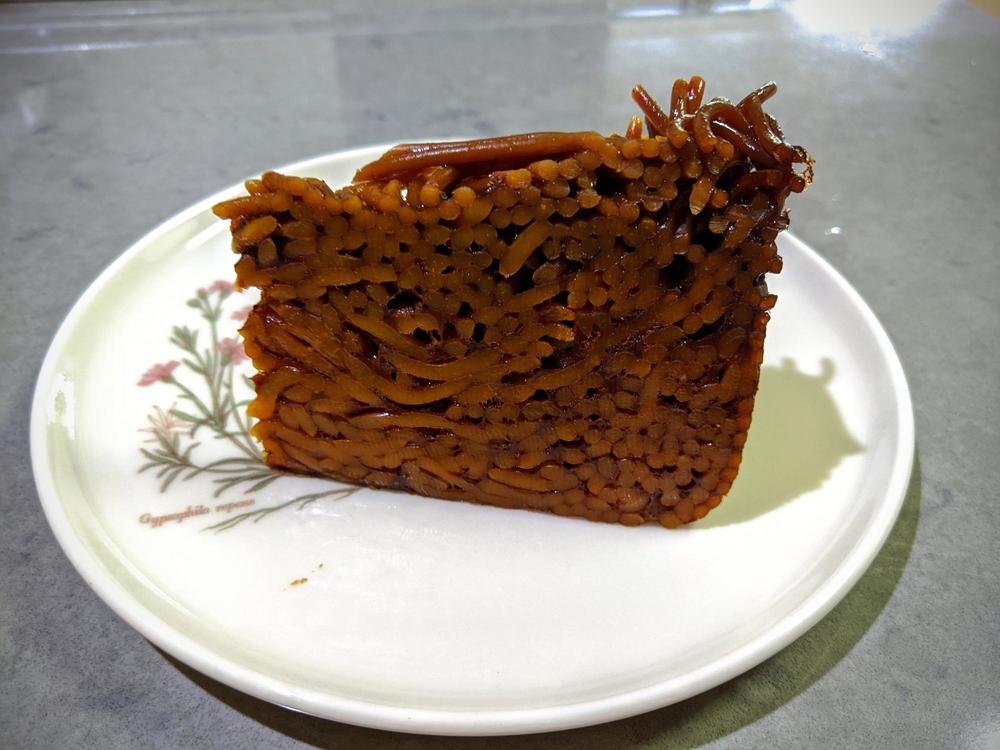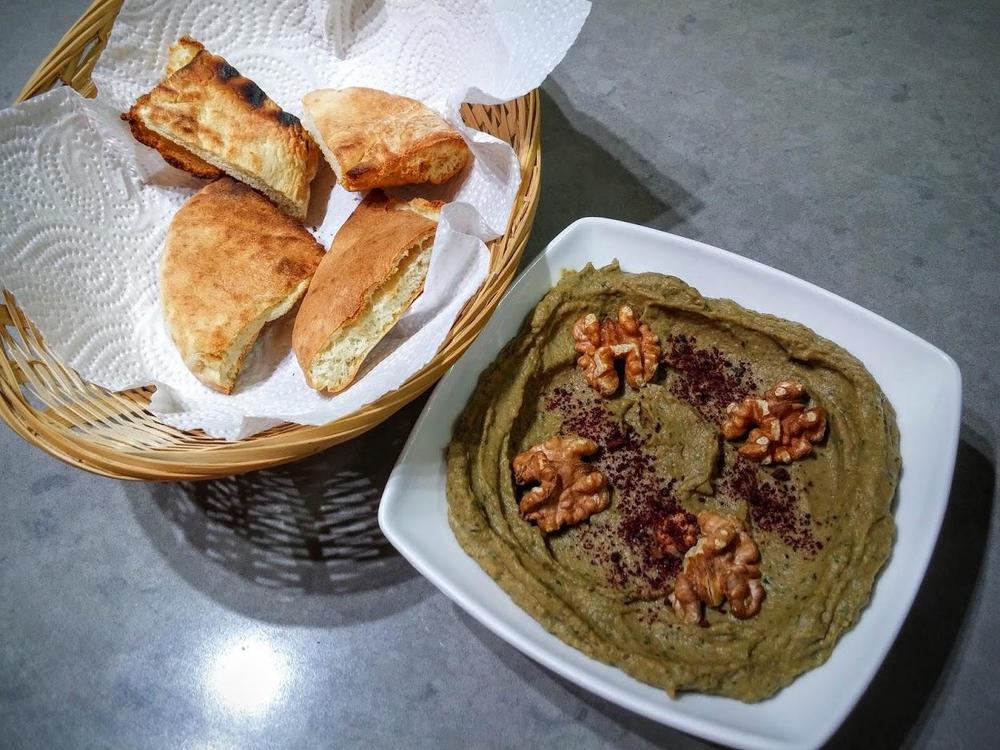Search the Community
Showing results for tags 'Recipe'.
-
250-300g dry soba noodles 100g peeled edamame (or peas, or green beans cut into short segments) 300g tofu, cut into small cubes 2 tbsp soy sauce 1.5 tsp sugar 3 small cucumbers, julienned 4-5 small spring onions, thinly sliced 4 garlic cloves, minced apx 4 tsp minced ginger 3-4 tbsp soy sauce 2 tbsp miso paste 2 tbsp sesame paste 4-5 tbsp lemon juice apx 1/3 cup of water dry chili flakes to taste salt to taste Blanch the edamame/peas/beans in salted water and shock in cold water. Drain well. Blanch the tofu and drain. Mix the tofu with 2 tbsp soy and 1.5 tsp sugar and gently heat in a small pot or in the microwave (the heat helps the tofu absorb the marinade). Cook the noodles in plenty of water and wash very well. If not serving soon, mix the noodles with a bit of oil. If serving all of the amount soon, mix all of the ingredients, otherwise, mix the sauce individually and add it to the noodles and vegetables before serving. Add more water as needed to give the sauce a creamy consistency. Scatter some toasted sesame seeds for garnish.
-
One large focaccia, or pizza. 485g bread flour (or 470g AP flour mixed with 15 g vital wheat gluten) 390g tepid water 15g salt 15g sugar 4g dry or instant yeast One to four days before baking: In a stand mixer bowl, mix water, sugar and yeast. Add flour and salt. Mix slowly until combined. Knead for 3-5 minutes. Let rest for 7-10 minutes. Repeat kneading and resting the dough for a total of 3-4 kneading cycles. Cover and refrigerate. Before baking: Knead the dough in its bowl (in a stand mixer, or with a spatula / large spoon). Lightly grease one large parchment paper. Pour the dough on the paper. Cover, with something that won't stick to the raising dough (I use a deep oven baking sheet). Let raise for 1.5 to 2.5 hours. ~ Preheat the oven with a baking steel or baking stone in it, to 250 d C, at least 45 minutes before it's time to bake. With wet hands, poke the dough to evenly distribute air bubbles and give it a roughly rectangular or circular shape. Place any toppings, such as herbs (rosemary's my go to), thinly sliced vegetables, etc. You can also use it to make pizza. Only put sauce at this point - cheese should be added only after the first bake. Place the parchment directly on the steel / stone and bake until the bread has risen, and only starts to deepen in color at spots, apx 8-10 minutes. Place on a cooling rack and remove parchment. Cool the breads at least partially, a minimum of 15 minutes. It can be frozen at this point. When ready to serve: Brush the bread with olive oil, the more the merrier. For pizzas, only brush the bottom side. If making pizza, this is the stage to add cheese. Place in a hot oven, 210dC to 230dC. Bake until the bread is crisp and reddish-golden, 7 to 15 minutes. Serve while warm, with olive oil for dipping, cheeses or as a sandwich.
-
Big Plate Chicken - 大盘鸡 (dà pán jī) This very filling dish of chicken and potato stew is from Xinjiang province in China's far west, although it is said to have been invented by a visitor from Sichuan. In recent years, it has become popular in cities across China, where it is made using a whole chicken which is chopped, with skin and on the bone, into small pieces suitable for easy chopstick handling. If you want to go that way, any Asian market should be able to chop the bird for you. Otherwise you may use boneless chicken thighs instead. Ingredients Chicken chopped on the bone or Boneless skinless chicken thighs 6 Light soy sauce Dark soy sauce Shaoxing wine Cornstarch or similar. I use potato starch. Vegetable oil (not olive oil) Star anise, 4 Cinnamon, 1 stick Bay leaves, 5 or 6 Fresh ginger, 6 coin sized slices Garlic. 5 cloves, roughly chopped Sichuan peppercorns, 1 tablespoon Whole dried red chillies, 6 -10 (optional). If you can source the Sichuan chiles known as Facing Heaven Chiles, so much the better. Potatoes 2 or 3 medium sized. peeled and cut into bite-sized pieces Carrot. 1, thinly sliced Dried wheat noodles. 8 oz. Traditionally, these would be a long, flat thick variety. I've use Italian tagliatelle successfully. Red bell pepper. 1 cut into chunks Green bell pepper, 1 cut into chunks Salt Scallion, 2 sliced. Method First, cut the chicken into bite sized pieces and marinate in 1½ teaspoons light soy sauce, 3 teaspoons of Shaoxing and 1½ teaspoons of cornstarch. Set aside for about twenty minutes while you prepare the rest of the ingredients. Heat the wok and add three tablespoons cooking oil. Add the ginger, garlic, star anise, cinnamon stick, bay leaves, Sichuan peppercorns and chilies. Fry on a low heat for a minute or so. If they look about to burn, splash a little water into your wok. This will lower the temperature slightly. Add the chicken and turn up the heat. Continue frying until the meat is nicely seared, then add the potatoes and carrots. Stir fry a minute more then add 2 teaspoons of the dark soy sauce, 2 tablespoons of the light soy sauce and 2 tablespoons of the Shaoxing wine along with 3 cups of water. Bring to a boil, then reduce to medium. Cover and cook for around 15-20 minutes until the potatoes are done. While the main dish is cooking, cook the noodles separately according to the packet instructions. Reserve some of the noodle cooking water and drain. When the chicken and potatoes are done, you may add a little of the noodle water if the dish appears on the dry side. It should be saucy, but not soupy. Add the bell peppers and cook for three to four minutes more. Add scallions. Check seasoning and add some salt if it needs it. It may not due to the soy sauce and, if in the USA, Shaoxing wine. Serve on a large plate for everyone to help themselves from. Plate the noodles first, then cover with the meat and potato. Enjoy.
-
Beef with Bitter Melon - 牛肉苦瓜 The name may be off-putting to many people, but Chinese people do have an appreciation for bitter tastes and anyway, modern cultivars of this gourd are less bitter than in the past. Also, depending on how it's cooked, the bitterness can be mitigated. I'll admit that I wasn't sure at first, but have grown to love it. Note: "Beef with Bitter Melon (牛肉苦瓜 )" or "Bitter Melon with Beef (苦瓜牛肉)"? One Liuzhou restaurant I know has both on its menu! In Chinese, the ingredient listed first is the one there is most of, so, "beef with bitter melon" is mainly beef, whereas "bitter melon with beef" is much more a vegetable dish with just a little beef. This recipe is for the beefier version. To make the other version, just half the amount of beef and double the amount of melon. Ingredients Beef. One pound. Flank steak works best. Slice thinly against the grain. Bitter Melon. Half a melon. You can use the other half in a soup or other dish. Often available in Indian markets or supermarkets. Salted Black Beans. One tablespoon. Available in packets from Asian markets and supermarkets, these are salted, fermented black soy beans. They are used as the basis for 'black bean sauce', but we are going to be making our own sauce! Garlic. 6 cloves Cooking oil. Any vegetable oil except olive oil Shaoxing wine. See method Light soy sauce. One tablespoon Dark soy sauce. One teaspoon White pepper. See method Sesame oil. See method Method Marinate the beef in a 1/2 tablespoon of light soy sauce with a splash of Shaoxing wine along with a teaspoon or so of cornstarch or similar (I use potato starch). Stir well and leave for 15-30 minutes. Cut the melon(s) in half lengthwise and, using a teaspoon, scrape out all the seeds and pith. The more pith you remove, the less bitter the dish will be. Cut the melon into crescents about 1/8th inch wide. Rinse the black beans and drain. Crush them with the blade of your knife, then chop finely. Finely chop the garlic. Stir fry the meat in a tablespoon of oil over a high heat until done. This should take less than a minute. Remove and set aside. Add another tablespoon of oil and reduce heat to medium. fry the garlic and black beans until fragrant then add the bitter melon. Continue frying until the melon softens. then add a tablespoon of Shaoxing wine and soy sauces. Finally sprinkle on white pepper to taste along with a splash of sesame oil. Return the meat to the pan and mix everything well. Note: If you prefer the dish more saucy, you can add a tablespoon or so of water with the soy sauces. Serve with plained rice and a stir-fried green vegetable of choice.
-
Beer Duck - 啤酒鸭 I understand that, unlike in China, duck is not a common meat in the USA, but it is worth searching out, especially for this dish from Hunan which is basically a duck stew, but full of exquisite flavors. I'm told that frozen duck meat is available in larger supermarkets or Asian markets in the US, but of course, as always, fresh is best. So much so, that your average Chinese home cook will buy the bird alive! Ingredients Duck. 1 lb. This dish calls for cubes of duck meat, preferably from the legs/thighs but breast meat will work too. Beer. One large can (16oz). Ideally you would choose a Chinese beer. Tsingtao is the most widely available internationally. Here in Liuzhou it would be Liquan Beer from Guilin. But actually, any well-flavored lager type beer will do the job. Cooking Oil. Vegetable oil - but not olive oil. If you have duck fat to hand, this is even better. Doubanjiang. 1 Tablespoon. Also called toban-djan or similar in the USA. This is a chile paste made with broad beans. Garlic. About 6-8 whole cloves Ginger. One thumb sized piece, finely chopped Dried Red chillies. One or more to taste. If you can source them, 朝天椒干 (cháo tiān jiāo gān, pointing to heaven peppers) or 七星椒干 (qī xīng jiāo gān, 7 star peppers) are best, otherwise long Indian peppers; not Thai or bird's eye chillies. Dried Tangerine Peel. One large piece - available from Asian markets and stores. Star Anise. One Light Soy Sauce. 1 Tablespoon Dark Soy Sauce. 1 Tablespoon Scallions. Salt. Method Wash and thoroughly dry the cubed duck meat. Heat oil or fat and add the garlic and ginger. When you detect their fragrance, add the duck and stir to brown the meat. When browned, add the doubanjiang and stir for a couple of minutes. Add the two soy sauces, the chillies, star anise and tangerine peel. Cover with beer. Add salt. Cover the pan and simmer for 30 - 40 minutes, adding more beer if it begins to dry out. Finish by discarding the star anise and tangerine peel, but adding thinly sliced scallions and serve. Accompany with steamed rice and a stir fried green vegetable of your choice. I like spinach. Drink any remaining beer! You didn't just buy one can, did you?
-
Stir-fried Squid with Snow Peas - 荷兰豆鱿鱼 Another popular restaurant dish that can easily be made at home. The only difficult part (and it's really not that difficult) is preparing the squid. However, your seafood purveyor should be able to do that for you. I have given details below. Ingredients Fresh squid. I tend to prefer the smaller squid in which case I allow one or two squid per person, depending on what other dishes I'm serving. You could use whole frozen squid if fresh is unavailable. Certainly not dried squid. Snow peas aka Mange Tout. Sugar snap peas can also be used. The final dish should be around 50% squid and 50% peas, so an amount roughly equivalent to the squid in bulk is what you are looking for. De-string if necessary and cut in half width-wise. Cooking oil. I use rice bran oil, but any vegetable cooking oil is fine. Not olive oil, though. Garlic. I prefer this dish to be rather garlicky so I use one clove or more per squid. Adjust to your preference. Ginger. An amount equivalent to that of garlic. Red Chile. One or two small hot red chiles. Shaoxing wine. See method. Note: Unlike elsewhere, Shaoxing wine sold in N. America is salted. So, cut back on adding salt if using American sourced Shaoxing. Oyster sauce Sesame oil (optional) Salt Preparing the squid The squid should be cleaned and the tentacles and innards pulled out and set aside while you deal with the tubular body. Remove the internal cartilage / bone along with any remaining innards. With a sharp knife remove the "wings" then slit open the tube by sliding your knife inside and cutting down one side. Open out the now butterflied body. Remove the reddish skin (It is edible, but removing it makes for a nicer presentation. It peels off easily.) Again, using the sharp knife cut score marks on the inside at 1/8th of an inch intervals being careful not to cut all the way through. Then repeat at right angles to the original scoring, to give a cross-hatch effect. Do the same to the squid wings. Cut the body into rectangles roughly the size of a large postage stamp. Separate the tentacles from the innards by feeling for the beak, a hard growth just above the tentacles and at the start of the animal's digestive tract. Dispose of all but the tentacles. If they are long, half them. Wash all the squid meat again. Method There are only two ways to cook squid and have it remain edible. Long slow cooking (an hour or more) or very rapid (a few seconds) then served immediately. Anything else and you'll be chewing on rubber. So that is why I am stir frying it. Few restaurants get this right, so I mainly eat it at home. Heat your wok and add oil. Have a cup of water to the side. Add the garlic, ginger and chile. Should you think it's about to burn, throw in a little of that water. It will evaporate almost immediately but slow down some of the heat. As soon as you can smell the fragrance of the garlic and ginger, add the peas and salt and toss until the peas are nearly cooked (Try a piece to see!). Almost finally, add the squid with a tablespoon of the Shaoxing and about the same of oyster sauce. Do not attempt to add the oyster sauce straight from the bottle. The chances of the whole bottle emptying into your dinner is high! Believe me. I've been there! The squid will curl up and turn opaque in seconds. It's cooked. Sprinkle with a teaspoon of so of sesame oil (if used) and serve immediately!
-
Clam Soup with Mustard Greens - 车螺芥菜汤 This is a popular, light but peppery soup available in most restaurants here (even if its not listed on the menu). Also, very easy to make at home. Ingredients Clams. (around 8 to 10 per person. Some restaurants are stingy with the clams, but I like to be more generous). Fresh live clams are always used in China, but if, not available, I suppose frozen clams could be used. Not canned. The most common clams here are relatively small. Littleneck clams may be a good substitute in terms of size. Stock. Chicken, fish or clam stock are preferable. Stock made from cubes or bouillon powder is acceptable, although fresh is always best. Mustard Greens. (There are various types of mustard green. Those used here are 芥菜 , Mandarin: jiè cài; Cantonese: gai choy). Use a good handful per person. Remove the thick stems, to be used in another dish.) Garlic. (to taste) Chile. (One or two fresh hot red chiles are optional). Salt. MSG (optional). If you have used a stock cube or bouillon powder for the stock, omit the MSG. The cubes and power already have enough. White pepper (freshly ground. I recommend adding what you consider to be slightly too much pepper, then adding half that again. The soup should be peppery, although of course everything is variable to taste.) Method Bring your stock to a boil. Add salt to taste along with MSG if using. Finely chop the garlic and chile if using. Add to stock and simmer for about five minutes. Make sure all the clams are tightly closed, discarding any which are open - they are dead and should not be eaten. The clams will begin to pop open fairly quickly. Remove the open ones as quickly as possible and keep to one side while the others catch up. One or two clams may never open. These should also be discarded. When you have all the clams fished out of the boiling stock, roughly the tear the mustard leaves in two and drop them into the stock. Simmer for one minute. Put all the clams back into the stock and when it comes back to the boil, take off the heat and serve.
-
100 g hollow pasta shape (macaroni, bucatini, ditalini, penne, etc.) apx 175g spinach leaves, finely chopped 2 small spring onions, sliced finely 2 garlic cloves, minced apx 100g feta cheese, not too dry apx 10-15g parmesan cheese, grated or finely chopped 8-10 Kalamata or other similar olives, sliced 5 large eggs apx 30g (2 tbsp) milk Salt to taste (I needed 1/2 a tsp, but it depends on the cheese) For quick tomato sauce (optional): 4 saucing tomatoes, finely diced (e.g. Roma, San Marzano) 4 garlic cloves, finely chopped (or less if you are not a garlic lover) 8 olives, sliced salt to taste you can add some herbs to you liking Cook the pasta a minute less than al-dente. Drain and wash to chill. Cook the spinach well. I just use a microwave to cook it for 3 minutes. Mix everything (but the sauce ingredients). Pour into an oiled and heated pan, or as I did, a greased silicon mold. Bake at 180dC until set through the middle, avoid overcooking. Apx 20 minutes. Serve warm. To make the sauce, just cook the tomates until slightly soften and no longer tastes raw. Add garlic and olives, and cook a little more, until sauce achieves a cooked but bright taste. It should remain quite chunky .
-
This is an improvised recipe that uses leftover rice.I made a few adjustments made after first having it, but by nature it is open for modifications and adjustments. If you are up to it, I think those will be amazing battered in a thin (tempura like) batter and deep/pan fried. apx 340g cooked cooled short grain rice (about 2/3 cup, I think) that's how much I happened to have, no need to be accurate. Fresh rice can be used, but maybe under-cook it by a couple of minutes 4 eggs 50g water (1/4 cup) a large bunch of young garlic chives, chopped 3 scallions, chopped 1 large garlic clove, finely chopped or minced apx 3 tbsp worth of finely chopped ginger 2 tsp sesame oil 2 tsp oyster suace 5 tsp soy sauce (roughly 2 tbsp) black pepper, generously optional MSG, a couple of sprinkles, to taste chili flakes, to taste I haven't used any, but I suggest adding some Sichuan peppercorn, maybe 1/2 tsp, toasted and ground apx 2/3-1 tsp salt, to taste. Even less if your rice is already salted For dipping sauce: 3 tsp oyster sauce 2 tsp black rice vinegar chili oil Prep: Mix everything. Divide across 12 cups of an oiled muffin tin. Bake at 200dC until set, apx 15-20 minutes. Serve with dipping sauce.
-
Kubaneh is a rich "pull apart" bread of Yemenite Jewish origin. It is baked overnight and served on the Sabbath for lunch or breakfast. Flavored with butter, slowly caramelized sugar and fenugreek, it has a delightful savory-sweet aroma of butterscotch and brioche. While it has a decent amount of sugar, it's no sweeter than a dinner roll, as the long baking time breaks down the sugar into aromatic caramel. It is actually most often served with savory sides. That said, my favorite serving options is with s drizzle of honey and a sprinkle of salt. It's really no harder to make than a simple brioche or challah. Since the baking time is long, consider doubling the recipe, it can be frozen quite well. Actually, in some ways it is better reheated, since the outer crust can be crisped. My recipe uses dark brown sugar, which is not traditional, but gives it a striking dark color that I love, and further butterscotch notes. You can use white sugar. Some recpies uses date molasses or plum/apricot jams. Ingredients: 6g dry or instant yeast 240g water 60g dark brown sugar (or other sugars, see note above) 375g flour 8g salt 1 tsp 1.5 tsp fenugreek seeds, finely or roughly ground (don't worry if your not a fan of it, it mellows while baking and leaves a lovely fruity-spicy maple-like scent) optional: 1 tsp nigella seeds ~~~ 40 to 60 g soft butter, for rolling 15 to 30 g soft butter, for covering the rolled dough ~~~ optional: nigella or sesame seeds for decoration. Prep: Two to three days ahead: In mixer bowl, mix yeast, water and sugar. Add flour, salt and spices. Knead for ~7 minutes until a firm dough is formed. Let the dough relax for apx. 10 minutes. Knead for another ~7 minutes or so until strong. Cover tightly and refrigerate overnight and up to 2 nights. Evening/night before: Transfer the dough onto a lighlty oiled surface. Flatten and roll into an elongated rectangle, try to get it to be 80cm (2.5 ft) wide, but don't worry if it is shorter. Spread 40 to 60 of butter over the dough. Roll it tightly in order to receive a long log shape. Divide the "log" into 12 segment. Roll each segment against the surface to elongate it to apx 12-15 cm (~5"). Spread remaining 15 to 30 g of butter on the rolls, covering them well. Place the rolls standing in a pot wide and deep enough to contain the bread once risen. For this amount, I use a pot with a 20cm diameter. Optionally scatter some nigella or sesame (just a sprinkle, don't over do it). Cover tightly with a tin foil, followed by the pot's lid. Let rise for ~ 30 to 45 minutes. Place in a preheated 210C oven (410F) for ~20 minutes. Lower the heat to 100C (210F) and bake overnight. For haminados eggs - place raw or leftover boiled eggs (unpeeled!) in the oven along the bread (I usually leave them in their cartoon). Morning/noon: Before serving, drizzle ~1/5-1/4 cup of water onto the bread. Cover and return to the oven for another 15 minutes or until ready to eat. To serve, remove from the pot. Eat while warm. For serving: Traditionally, it is often served with: Haminados eggs, baked all night long Fresh tomatoes blended or grated into chunky sauce and flavored with zchug (chili paste) and salt Pickles Fresh veggies Some fresh salty or acidic cheeses Arak or ouzo It can also be eating with honey and a sprinkle of salt. Leftover eggs are great in a sandwich with tomatoes, tahini sauce, pickles and zchug. My shaping skill is still not great (rolled to thick), but it will taste great regardless.
-
apx 175g green/brown lentils, soaked overnight /a few hours 1.5 tsp salt ~ apx 250g (1.5 cups) bulgur soaked overnight /a few hours - I strongly suggest that you use unbroken bulgur (aka extra coarse / coarse) generally, I use only whole bulgur when cooking, other than for some rare usages such as tabbouleh. salt optional: 2 tsp nutritional yeast ~ 5-6 onions, apx 750g, diced butter or oil 3 cloves of garlic, minced 2.5 tsp cumin, ground chili flakes to taste 1/2 to 2/3 tsp allspice, ground 1/2 tsp curry powder 1/2 tsp cardamom, ground 1-2 tsp cinnamon, ground black pepper ~ 2 tbsp sumac apx 3 tbsp lemon juice optional: a handful of parsley, chopped To serve: A generous amount of thick yogurt Toasted pine nuts or slivered almonds Prep: Cook the lentils in water with salt. Drain and reserve cooking water. ~ Discard bulgur soaking water. Cook in a covered pot, over low flame, adding a little lentil cooking water or plain water as needed. Stir occasionally. Cooked bulgur should have a bite to it, but cooked through. Add salt and optional nutritional yeast. ~ In a wide pot, saute the onions in butter/oil until well caramelized. Add a little more fat and briefly fry the garlic. Add the spices (other than sumac) - cumin, chili, allspice, curry powder, cardamom, cinnamon, black pepper. Cook briefly. Mix in the cooked bulgur and lentils. Heat through. Adding lentil cooking water or plain water as needed to keep the mujadara "juicy". Add sumac, lemon, parsley and salt to taste. Serve with yogurt. Top with nuts.
-
5 eggs ~120g dry (~240g cooked) mung beans, small chickpeas or cow peas ~200-250g grean beans (cut to size) or okra (what I get is small, so I leave it whole) 1 spring onion, thinly sliced sauce: ~1 tbsp butter or coconut oil 2-3 cloves of garlic, minced 1 chili pepper (I used a jalapeno) de-seeded and thinly sliced up to 1/3 tsp hing (I love this dish with a strong flavor of hing, but many people can find this spice off putting, please add to taste) 1/2 tsp fenugreek, ground - 1/2 tsp fennel seeds, ground 1/2 tsp cumin, ground 1/2 tsp turmeric 1 tsp ready mixed curry powder (mine is mostly turmeric, cumin, black pepper coriander, fenugreek with some cinnamon and cardamom) Optional: a flat tsp of nutritional yeast or a pinch of MSG 150g thick tart yogurt 2-4 tsp vinegar, to taste (I use apple vinegar) optional: a little minced cilantro salt to taste Cook the legumes and drain. Either stir fry, saute or blanch the green beans / okra until tender but retain a bite. Cook the eggs into a scramble with large distinct pieces, or into an omelette and cut into pieces. - In a pot, heat the butter/oil and briefly cook the garlic, chili, hing and fenugreek until just aromatic. Add fennel, cumin, turmeric, curry powder. Cook until the spices are aromatic and absorbed the fat. Add yogurt, optional nutritional yeast / MSG. Add vinegar, cilantro and salt, all to taste. Add the green onion, cooked beans and green beans / okra and cooked eggs. Mix gently and adjust seasoning and add water/yogurt as needed. Cook gently to warm through and allow the flavors to come out. Best served along a second curry/chutney/dish that has some sweetness to it.
-
One of my favorite pasta dishes, and a really simple one to make. ~5 serving (you know how much pasta you can eat ). 400g rigatoni, or penne (or whatever pasta you want) 1 tbsp butter or olive oil 1 medium onion, diced (~1cm) or thinly sliced ~ 300g ripe saucing tomatoes (2 large) ~ 450g cherry tomatoes, halved ~ 80ml cream (or twice that amount of half-fat cream) dried chili to taste salt to taste black pepper 1/5 cup vodka (optional) To serve: Plenty of chopped chives Grated Parmesan cheese, around 30g A good wine for drinking Arrange the cherry tomatoes in a wide shallow pot or a wide pan, cut side up. Place over high heat and cook until blistered, but not charred. Set aside. Heat butter/oil and saute the onion until lightly golden (I do so in the same pot). Blend together the cooking tomatoes (not the blistered ones!) and the garlic. Add to the onion. Cook over low heat, uncovered for apx 15 minutes until thickened. Add the blistered tomatoes, the cream, vodka (if using) and chili flakes. Cook the pasta shy of al dente, drain but keep some of the water. Add to the sauce and cook, adding cooking water as needed, until al dente. This takes a few minutes. Add salt and pepper to taste. For serving, add plenty of chives and Parmesan . Also great with soft boiled eggs and a crisp warm bread.
-
This is a recipe Iv'e been making for years, at least once per summer. It's quick to make, and I often divide into two pans, and refrigerate them, to be baked as a quick weekday dinner. 500g fusilli pasta 250g dry mozzarella cheese - diced (apx 1cm sized cubes) 40-100g cream (full fat, or a larger amount of half and half) - I usually go with 40g, but we tend to prefer things not overly rich 4 large tomatoes (or 6 medium ones), preferably drier varieties, such as Roma tomatoes - cut into stripes 8-9 minced garlic cloves - minced apx 35g basil - chopped + more for serving optional: 1-2 tsp nutritional yeast plenty of pepper salt to taste, 1-2 tsp (I'm a salt lover and often use 2, but it also depends on the saltiness of the cooking water) Cook the pasta a little shy of al dente. Drain well, let cool a bit. Place in a large bowl, mix in remaining ingredients. Can be refrigerated at this point. Place the entire amount or half of it in a shallow casserole dish that will contain the pasta so that it is not too tall - you want plenty of surface area. Bake under a low broiler (~220-230 deg C) for apx. 40-50 minutes until the top browns very deeply and the pasta is very crisp. Scatter some more basil. Serve immediately.
-
I Forget where I found this recipe, but I've played with it for a long time. This is one of those "if I had a restaurant it would be on the menu" recipes. You can make most of the parts well ahead of time, so actual cooking involves searing the salmon and assembling the dish. A pesto is a nut and an herb, with garlic and oil; this uses frozen peas as the 'nut' and mint as the herb. Ingredients Lemon Broth 1 tbsp olive oil 1 shallot, diced 1/2 lemon, zested (use the lemon you’ll be juicing - so you only need one lemon total) 1 lemon, juiced 1 cup chicken broth 1/2 tbsp chopped fresh mint leaves Pea Pesto 1 cup frozen peas. 2 tbsp fresh mint leaves 1 clove garlic (I always use about 3, but I like garlic) 1/4 cup extra-virgin olive oil 1/4 cup grated Parmesan Salt and Pepper to taste Salmon 2 tbsp olive oil 2 (6-8 ounce) salmon fillets Kosher salt Freshly ground black pepper 1/2 lb pasta of your choice. Orecchiette, rigatoni and penne would all work great. I love using the black-and-white bow ties striped with squid ink. Make the broth: Warm the olive oil in a medium saucepan over medium heat. Add the shallots and saute until tender, about 7 minutes. Add the lemon juice, zest, and broth. Bring to a simmer, and keep warm, covered, over low heat. You can also easily make this ahead of time and just refrigerate until needed, then rewarm. Make the pea pesto: Combine the peas, mint, garlic, salt, and pepper in a food processor and puree. With the machine running, add the olive oil in a steady drizzle. Note that there is no need to thaw the peas. You can do so, and you will get a smoother mix. I like the peas frozen so that the pesto is a bit chunky. Transfer the pea puree to a small bowl and stir in the Parmesan. Set aside. You will want to warm this before you put it on top of the salmon. Not hot, just warm. What I do is pop it in the microwave for about 20 seconds. When it’s all hot and summery out, I can see using this room temperature or slightly chilled. If you're going to reheat, don't put the cheese in until after, as it will get stringy. Make the salmon: Warm the olive oil in a large, heavy skillet over high heat. Season the salmon pieces with salt and pepper. Sear the salmon until a golden crust forms, about 4 to 5 minutes on the first side. This is also a good point to add your pasta to your boiling water and get that cooked. Flip the fish and continue cooking for about 4 more minutes more depending on the thickness of the fish, and how you like it cooked. Remove fish from pan and cover with foil until you are ready for it. Assemble: Add the tablespoon chopped mint to the lemon broth and divide between 2 shallow dishes. Add some pasta to each dish. Don’t pile it on like a big bowl of pasta but more like the little pasta-broth bed for the salmon that it will be. Place a salmon piece in each bowl and add a generous spoonful of pea puree. A mint leaf makes a great garnish. Serve immediately. Since I am normally cooking for two, I save half of the pesto for the next day. Don't mix any cheese in that half, as reheating will make it stringy. And as with most recipes, there really isn't any such thing as too much garlic.
-
A simple side or appetizer, those are blintzes with no filling. 2 eggs 1 medium-large garlic clove 200ml milk 300ml water 200g white flour 100g rye flour (or wholemeal flour or more white flour) 2/3 tsp salt 1 tsp sugar optional: 1 tsp nutritional yeast or a touch of MSG plenty of pepper - 150g finely grated cheddar or another similar hard cheese 50 g dill, finely chopped (if your'e not a fan of dill, you can use other herbs, like chives) - For serving: sour cream flavored with a little salt and optionally pepper and herbs. Blend together eggs, garlic and milk. Add water, flours, salt, sugar, nutritional yeast / MSG, pepper. Blend until uniform. Add cheese and dill. Mix well but do not blend smooth. - Heat a largish non stick pan over medium-high heat. Lightly brush with oil. Pour some batter into the pan and spread around by tilting the pan in a circular motion. You want as thin of a blintzes as you can get, it takes a couple of attempts to get the amount of batter right. Don't worry about holes or the blintzes shape. Cook until nicely golden-brown from below, flip and cook a few more seconds. Set aside. Repeat cooking the remaining batter, lightly oiling the pan every 3-4 crepes. - Roll the blintzes thinly, for best appearance, tack the sides in while rolling, as if they have a filling. Before serving, heat in an oven or a non stick pan. Serve with sour cream for dipping. Try tearing pieces from the blintzes as well as biting from the rolled shape Both the batter and blintzes can be made ahead. For variation, you can try adding peas as a filling, or maybe farmers cheese.
-
I think of Panang curry as being an interesting Thai curry - not just because it's delicious, but I can't think of another Thai curry that is like it. Most Thai curries that I can think of are pretty thin - almost soup consistency, however, Panang curry is thick, so that it coats whatever it touches. With that in mind, the way I make it is not dissimilar to how I'd make Malay or Nyonya curries which typically have a similar texture. There are probably a million ways to make this curry, but this how I've been doing it lately. I usually don't have the time to make my own curry paste, so I use a store bought. If it's possible to get, I prefer the Nittiya brand of curry pastes - it comes refrigerated (it freezes well too) and has the closest flavor to what I've had in Thailand. Unfortunately, it's really hard to come by - when I go to the Thai store, they say they bring it in every few months, and when they do, it's gone in the same day. Of course, this prompts me to wonder why they don't bring in more, but also, I can't make it into that store all that often, so lately, I can never find it. 2nd place, that I've tried, is Maesri - in the can. Although the ingredients between the can and tub versions look the same, for some reason the can tastes fresher, although I've never tried them side by side. Maesri does not add shrimp paste or ground peanuts to its Panang paste, so you need to add them yourself... also, keep in mind that Maesri's Panang paste and red curry paste seem extremely similar... I think the Panang paste has a bit more ground cumin and coriander seed than the red paste, but I wouldn't swear by it. So, I add my own - and I also use some Mace, which is what a Thai cooking teacher told me in Chiang Mai years ago... Finally, a note about coconut milk. I'm not too fond of the canned milks - they typically have stabilizers added, which make it really hard for to use. For a long time, I was using an unbranded frozen coconut milk that I found in the Thai store, as well as the Indian store near me. The only label was that it was made in Thailand and brought in by East Distributors or something like that. It was good, but quite expensive. Lately, I've been using the Aroy-D coconut milk that comes in a shelf stable carton. Evidently, there are a couple different versions made, so make sure you check the label. I've found them on Amazon - a six pack of 250ml cartons - on some of the versions the label says 100% coconut milk - that's the one you want... other versions have stabilizers or homogenizers added. I give it a good shake before I open the carton. Anyway, my recipe is based on convenience sizes - I don't think the quantities are super critical... I typically make this with skinless boneless chicken thighs - I use 4 normal thighs worth of chicken. This goes well with 1 carton of coconut milk, and 1 can of curry paste. Ingredients: Curry paste: about 1t whole cumin seeds, toasted about 1T whole coriander seeds, toasted 1 piece of whole mace, very lightly toasted about a handful of roasted peanuts - unsalted preferably about 1t shrimp paste 1 can Maesri Panang or Red curry paste - probably about 3-4 heaping Tablespoons 4 normal sized boneless, skinless chicken thighs, trimmed and cut into 1" cubes (roughly) a few squirts of fish sauce a couple teaspoons veg oil (I use a homemade garlic oil (made from peanut oil) that I keep in my fridge) 250ml (about 1 cup) coconut milk, divided about 1T palm sugar about 10 kaffir lime leaves, ribs removed, torn into pieces. (nb - if your lime leaves are a little tough, you might want to finely shred rather than tear into pieces) Method: 1. Marinate chicken with the fish sauce and oil for about 1/2 hour 2. Grind cumin, coriander and mace in spice grinder until very fine 3. Add peanuts and pulse the spice grinder - if you go too fast or to far, it will turn into peanut butter and muck up your grinder 4. Add shrimp paste and ground spice/peanut mixture to curry paste and mix well. Sometimes you need to mash the shrimp paste a bit to get it to incorporate 5. Pour about 3/4 of the coconut milk into a 4Q saucepan, and then add a bit of water to the remaining coconut milk to bring it back up to about 1/2C 6. On medium - medium/high heat, bring the saucepan coconut milk to a boil and reduce until thick, stirring and scraping the bottom often to prevent scorching. 7. Add the curry paste to the coconut milk and stir to completely incorporate, stirring/scraping constantly 8. Add the kaffir lime leaves and palm sugar and continue to cook until you start seeing the oil bubble out of the edges of the paste. The paste should be considerably drier by now 9. Add the marinated chicken, and stir to completely coat with the paste. Cook until you don't see any more raw chicken (it's probably about halfway cooked through by now) 10. Add the remaining coconut milk/water and stir to combine. Simmer until chicken is cooked through. 11. Taste to adjust seasoning. If more salt needed, add fish sauce. If more sweetness needed, add palm sugar.
-
Makes 8 large buns. Make the dough 1-3 days ahead of baking. Dough: 380g AP flour 20g whole flour (or more AP flour) optional: 10g dried onion flakes (1 heaping tablespoon) 3g dry yeast 20g sugar (I reduce 10g and add 30g malt syrup) 9g salt 275g room temp water 15g butter, cubed Onion mixture: 2 large onions (350g), finely diced 15g butter (~1 tbpsn) 20g poppy seeds 1/2 tsp salt 3 tsp water Dough prep: Dissolve the yeast in the water. In a mixer (or by hand), mix all of the dough ingredients until a dough forms. Knead for ~5 minutes, then let rest for ~10 minutes. Repeat kneading a total of 3 or so times, until the dough is strong. Cover and refrigerate overnight and up to 3. On day of baking, prepare the onion, mixture: Set aside ~2 tablespoons of the chopped onion. Lightly caramelize the remaining onion in the butter. Add water, salt, poppy seeds and raw onion that was set aside. Chill. Shaping and baking: Prepare two baking sheets with parchment paper. Dust you working surface with flour. Divide dough into 8 equal pieces. Shape each into tight balls. Place each on a dusted towel or surface. I prefer working with semolina rather than flour. Cover and let rise until almost doubled in size, fluffy and very relaxed - for 1.5-2.5 hours. Meanwhile, heat the oven to 240 C. Dust each with semolina and/or flour, lightly flatten, and gently stretch the center, similarly to shaping a tiny pizza, but retaining the air around the edge. Place each on the parchment lined baking sheet, 4 per sheet. Portion the onion mixture on top of the center of each. Bake until fully rised, and lightly browned, possibly with slightly darker spots. Remove onto cooling rack. Brush with butter. Let cool for ~15 minutes. Before serving - return to a hot oven (temperature no critical) and bake for 3-7 more minutes, until they gains a little more color. Serve with cream cheese.
-
~175g matzo (5 matzo), broken into rough pieces 2 large leeks, white and light green parts only, thinly slices 4-5 scallions, chopped 5 eggs 250g milk 150g kashkaval cheese (or similar), grated 100g feta, crumbled 1 tbsp lemon juice, or a little vinegar 1/2 tsp baking powder A pinch of MSG (skip it if you avoid it) Plenty of black pepper Chili pepper, to taste Salt to taste (depends on the saltiness of the cheese, apx 1 tsp) The mixture can be made a day ahead. Place broken matzo in a large bowl. Heat the milk and pour over the matzo. This allowes for faster soaking, don't bother heating it if your making the mixture a day ahead. - Meanwhile, saute the leek until very tender. Mix into the matzo. - Make sure the matzo are not hot before mixing in the eggs and other ingredients. Pour into a well battered casserole dish. Lightly flatten. Bake in 200 C for 30-40 minutes, until nicely browned. Brush/top with butter mid-way baking for added crispness. - I find the dish to taste better, and be more crisp, once reheated. If you wish to, let it chill for at least 30 minutes or overnight before baking it again just until hot and crisp.
-
Matzo brei can be savory or sweet, and generally can be grouped into two forms. The first has the broken matzo cooked in a pan while stirring, producing a scramble of individual eggy pieces. The second is made by cooking the mixture into a pancake of sorts. My recipe is of the second type, which over the years I opted to bake in a cake pan, allowing me to have a wetter mixture and requires less work. I never tried to, but I'm pretty sure that this will work well with flatbreads instead of matzo. Dry the flatbread well in a low oven and weight them when dried. Base batter: ~ 280g matzo (8 matzo), broken into rough pieces 6 eggs 420g milk 150g water (reduce if cooking as "pancakes") 1 tsp baking powder Basic sweet version: Add: 5 tsp dark brown sugar or silan (date syrup) 1 tsp cinnamon 1.5-2 tsp salt 1/2 tsp black pepper optional: 2 tbsp milk powder optional: chopped walnuts, dates, raising, or other nuts and dried fruits By itself, the sweet version is not really that sweet, I usually serve it with one or more of the follwoing: Haroset Sour cream (or cottage cheese) and honey Maple syrup or silan Basic savory version: You can add whatever you think will suite stuffing or baked pasta. Cheeses - feta, Kashkaval, Swiss, etc. Vegetables - browned onions, leek, spinach, chard, mushrooms, etc. 2-3 tsp salt (2 should be enough if you add salty cheeses) Here's my favorite savory version - with leeks and cheese. Method: The batter can be made a day ahead. Place broken matzo in a large bowl. Heat the water and milk and pour over matzo. This allowes for faster soaking, don't bother heating it if your making the batter a day ahead. Let chill before mixing in the eggs and other ingredients. Let soak (an hour or so, at least). Once the liquid is mostly soaked, mix well and pour into a well battered cake pan, casserole dish or loaf pan. Bake in medium heat (180 C) for 30-45 minutes, until nicely browned and set. Brush the top with butter mid-way baking for added crispness. Serve hot. Reheats very well in oven or microwave.
-
A sweet spread often served during Passover. Serve on matzo, with matzo brei, or on toast. There are endless version. This is the one I make in recent years. 1 tart apple (Granny Smith), peeled and chopped, apx 150g 20g raising (skip if you can't bare them even when ground to a paste) 100g pitted dates / date spread (often vacuum packed, make sure it has no added sugar) - 40g toasted walnuts, chopped - 2 tbsp sweet or dry wine 1/2 tsp cinnamon a little black pepper a little nutmeg optional: rose water (strength vary, add to taste, maybe 1/2 tsp) optional: 1/4 tsp dry ginger a large pinch of salt a little lemon, if needed, to taste Cook the apple with the dates and raisins until the apple is tender. Add half to all of the nuts, and all flavoring ingredients. Blend smooth (or rough, if you prefer). Add remaining chopped nuts.
-
This is similar to Italian polenta. Bests served along sour cream, stews (of beans, mushrooms, or meat - for examples search for "tokana") and red wine. You have two options of serving it, resulting in different textures. If eaten fresh out of the oven, it is lightly set but creamy. If chilled overnight, it will solidify and resemble polenta made in the same fashion, at this point it eats more like cornbread. Ingredients for quick stock - you can use 500ml of a pre made vegetable or chicken stock instead, you can also use store bought stock: 6 bay leaves 3 all spice berries, cracked a few celery stalks or a large bunch of celery leaves (I have leaves left after using the stalk for mirepoix) optional: 1/2 carrot, chopped 550ml (2.5 cup) water or stock Ingredients for mamaliga: 250g of cornmeal 200ml (1 cup) milk 2 eggs optional: apx 100g of crumbled brained ewe milk cheese (e.g. feta) apx 80g somewhat aged cheese, ewe milk cheese is preferred (Burduf will be traditional, I use Manchego and and some smoked mozzarella) I appreciated the addition of smokiness, so if you don't include smoked cheese, maybe throw in a bit of smoked paprika or bacon salt to taste pepper some fresh thyme (optional and not traditional) Prep: If making a quick stock, cook the water, bay leaves, all spice, celery and carrot - covered, until flavors are extracted. A pressure cooker makes quick work at that. Drain the stock, add the milk and cornmeal. Cook while stirring and scrapping the bottom until it is thickened. Let cool a little and mix in the rest of the ingredients. Pour into a buttered casserole dish. Bake at high heat (210C) until the top is set, apx 30 minutes. Place a few small pieces of butter on top and let them melt. You can chill it overnight to end up with a firmer texture, or resume baking immediately to end up with a softer creamier (but still set) texture. Bake until the top is crisp and well browned, ~15 minutes, or longer if it was chilled. Serve with stews, sour cream and wine. This image is of it baked without chilling, as you can see, it is fully set, but not firm. And this is after crisping again the next day. Firmer, not as creamy. Can be eaten like cornbread.
-
Traditionally served as part of a brunch/lunch spread, along with sweet dill pickles. It can be also served as a dessert, I suggest having it along with some creme anglaise, sweetened ricotta or whipped cream if doing so. - 400g dry spaghetti - 250g sugar - a few tbsp of water - 50g butter - 80g milk (or water) - 5 eggs - 1 tsp salt - 1 to 1.5 tsp cinnamon - 1.5 tsp dry ginger - 2 tsp ground black pepper - a narrow and tall non stick pot, silicon mold or well greased aluminium pan. Choose a tall and narrow one for an impressive tall result. Prep: - Optional but recommended: toast the dry pasta in a low oven until light reddish-brown (careful, it can easily go too far). This will lend the kugel an impressive dark-brown color and better texture. - Cook the pasta al-dente. Drain well. - Meanwhile, make a caramel out of sugar and water. If using a non stick pot for baking, you can make the caramel in it. - Cook the caramel to an amber shade. If it is too dark, the result will not be sweet enough. You can add more sugar if it happen to darken too much. But make sure it's not burnt. - Remove from heat. - Add in the butter and mix. - Mix in the milk. - Mix the pasta into the caramel sauce. - Make sure that the pasta isn't too hot, then mix in the milk, eggs, salt and spices. Mix well. - Transfer to the baking pan/mold, or keep in the pot if its non stick. - Cover well with aluminum foil, as air tight as you can. - Bake for at least 9 hours and up to 16 (I haven't tried longer) at 90-100 deg C (195 F). - You can put a few eggs in the oven as well to make haminados eggs, which are excellent in sandwiches. - Before serving, pour 1/4 cup of boiling water on top of the kugel, then let it absorb for a short while. - Remove from the pan and slice to serve. - It reheats well in an oven or microwave. See also the more familiar apple kugel:
-
1.5 kg eggplants, peeled 100g well toasted walnuts 2.5 tsp coriander seeds 1-2 tbsp lemon juice 1/5-1/3 cup water 2 tsp carob molasses, date molasses, or dark brown sugar 3 tbsp chopped cilantro (optional) hot chili to taste freshly ground pepper, generously 1-2 tsp salt pomegranate kernels, for serving Cut the peeled eggplant into thick (2 cm) slices. Generously brush with oil from both sides. In a 220 deg C oven, bake until dark brown on both sides. Toast the coriander seeds until aromatic. Blend together all ingredients (other than the pomegranate) until smooth. Adding water as needed. Taste and adjust salt, lemon, chili. Serve at room temp, with pomegranate kernels on top. Eat with crisp warm bread, or pita chips.
-
This feeds 4 at my place. Ingredients 400g dry pasta - I prefer to use y "open" pasta e.g. conchiglie, orecchiette, pipe, castellane; but most short or long pasta shape will work. 130-150g walnuts, lightly toasted and roughly chopped For walnut sauce: half of the walnuts apx. 20g Parmesan 1/4 cup (60g) milk 1/4-1/2 tsp salt 1 tsp honey (optional) freshly ground pepper to taste a generous grating of nutmeg For ricotta: 200-250g ricotta cheese A good ricotta should be naturally sweet enough, but if not, you can add some honey a bit of lemon zest (optional) a little grated nutmeg (optional) salt to taste pepper to taste To serve: More grated Parmesan remaining half of walnuts a small drizzle of honey, per serving (optional) Method Toast the pasta in a 150 C (300 F) hot oven, until reddish-brown. If it starts to crack, that's the time to stop. Make sure to toast evenly, otherwise it won't boil evenly either. Mix together the ricotta mixture, set aside. Blend the walnut sauce ingredients together until smooth. Add a bit of milk if needed. Cook the pasta in salted water until it's to your liking. You will find that toasted pasta takes a while longer to cook. Meanwhile, bring the ricotta to a warmish serving temp. A careful short pass through the microwave does the trick. Mix the pasta with the walnut sauce, adding from the cooking water as needed. Taste and adjust. Plate the pasta. Place dollops of ricotta on the plate. Finish with chopped walnuts, Parmesan and honey.

